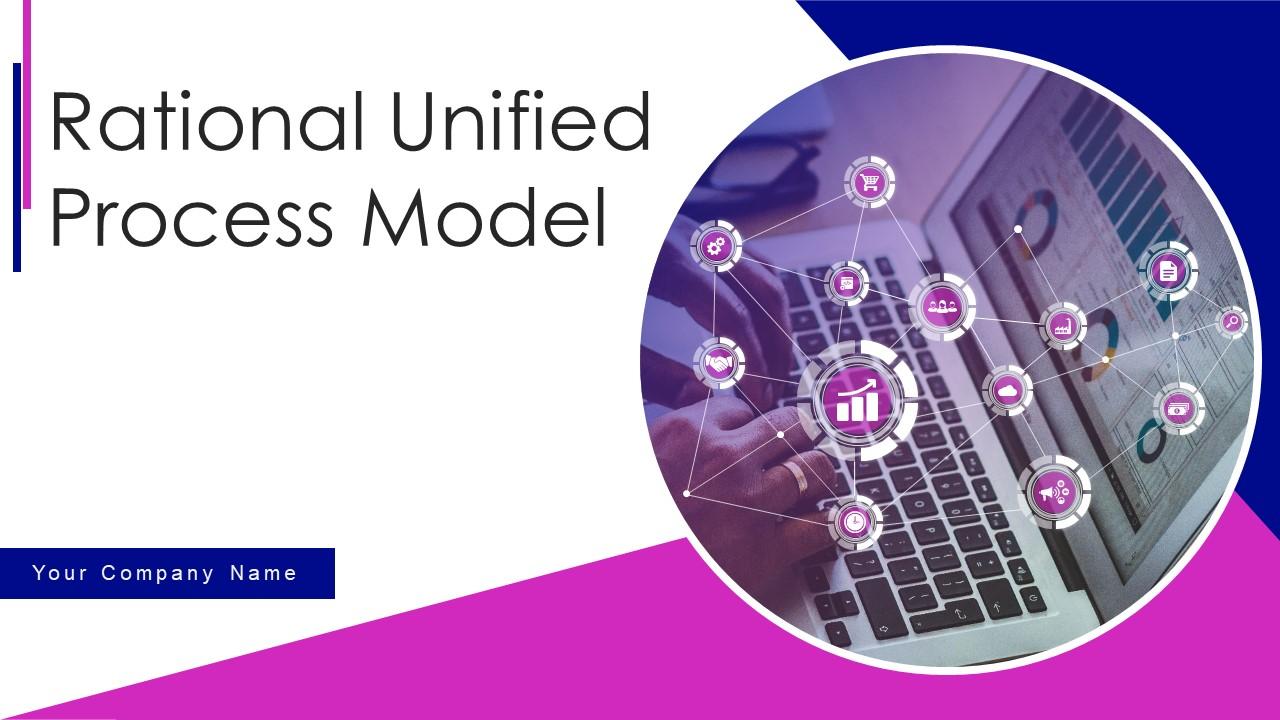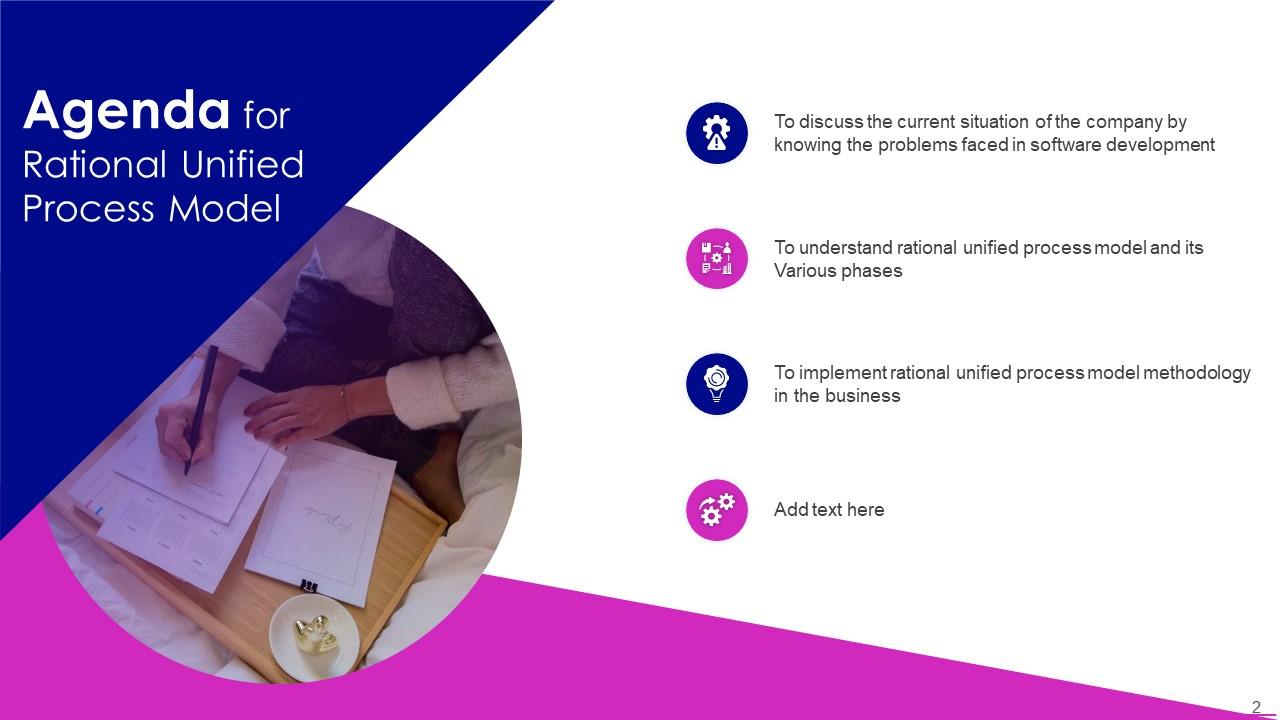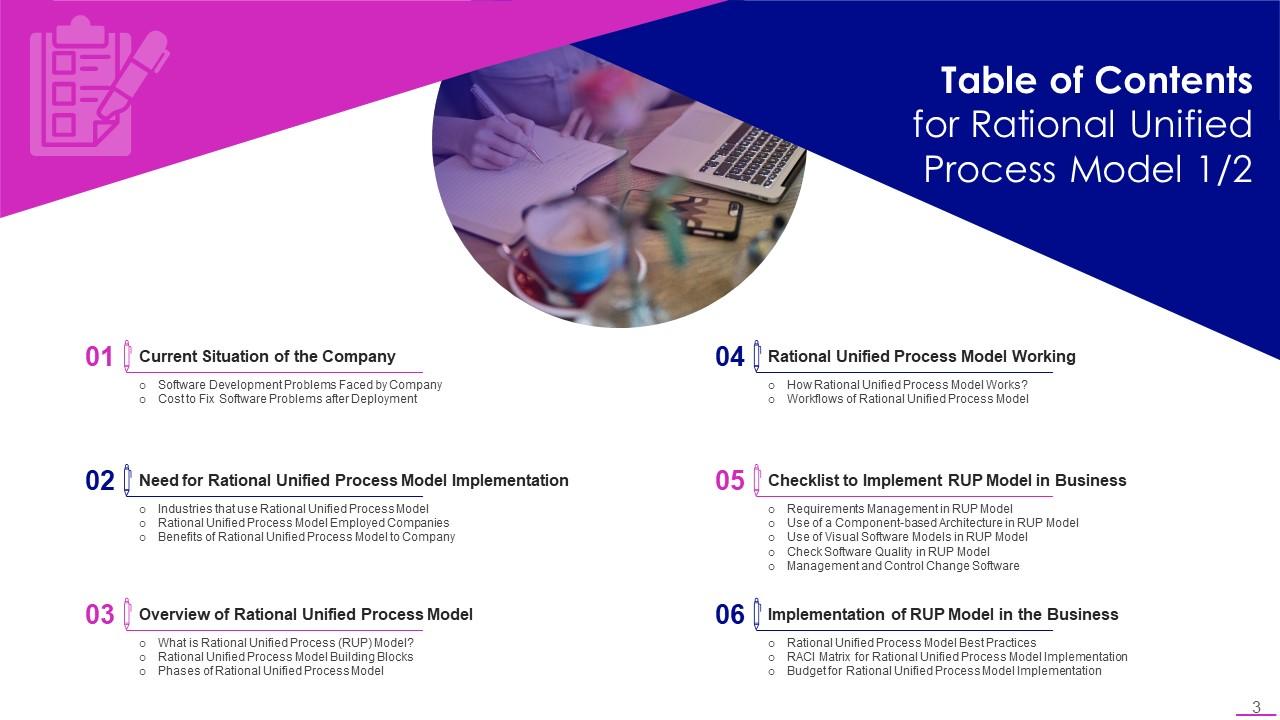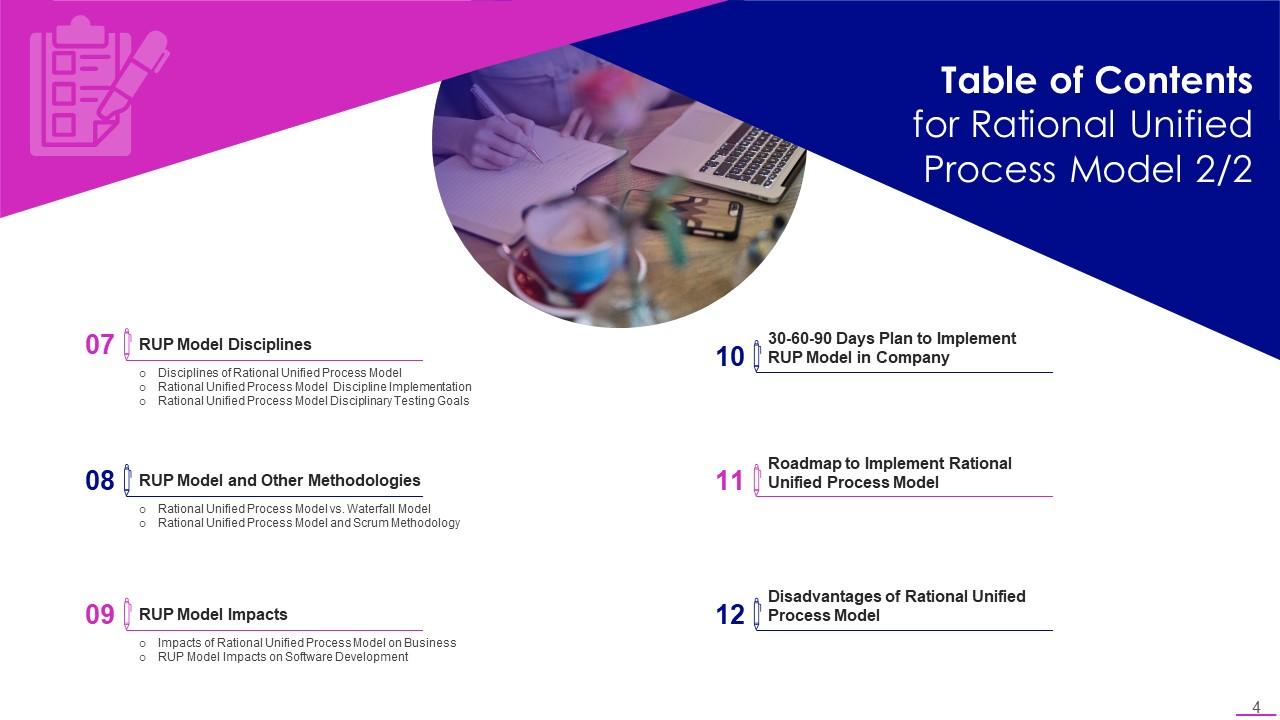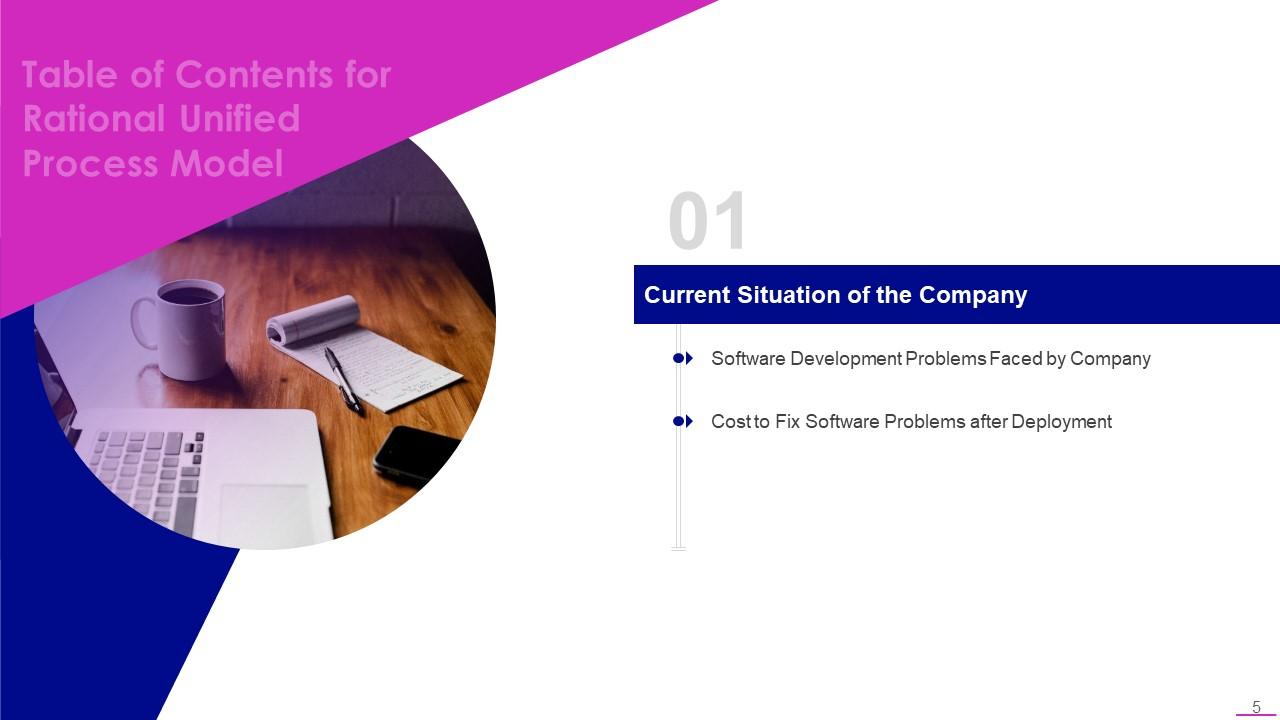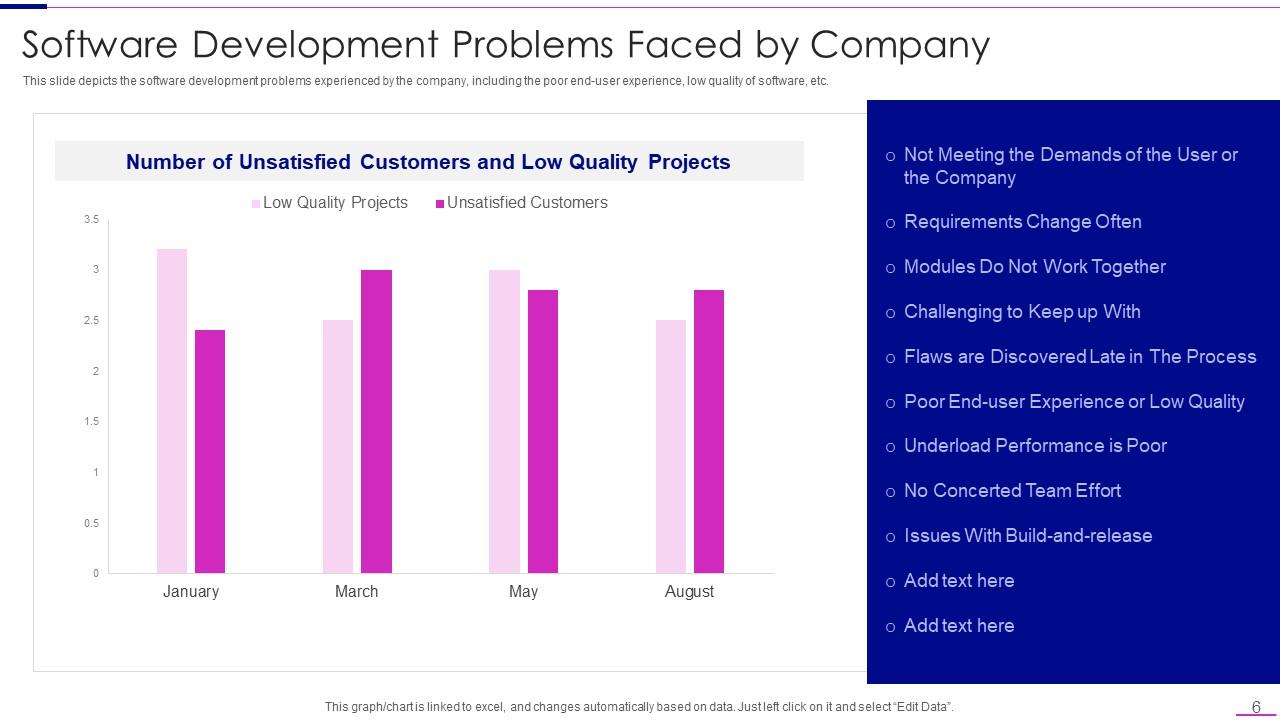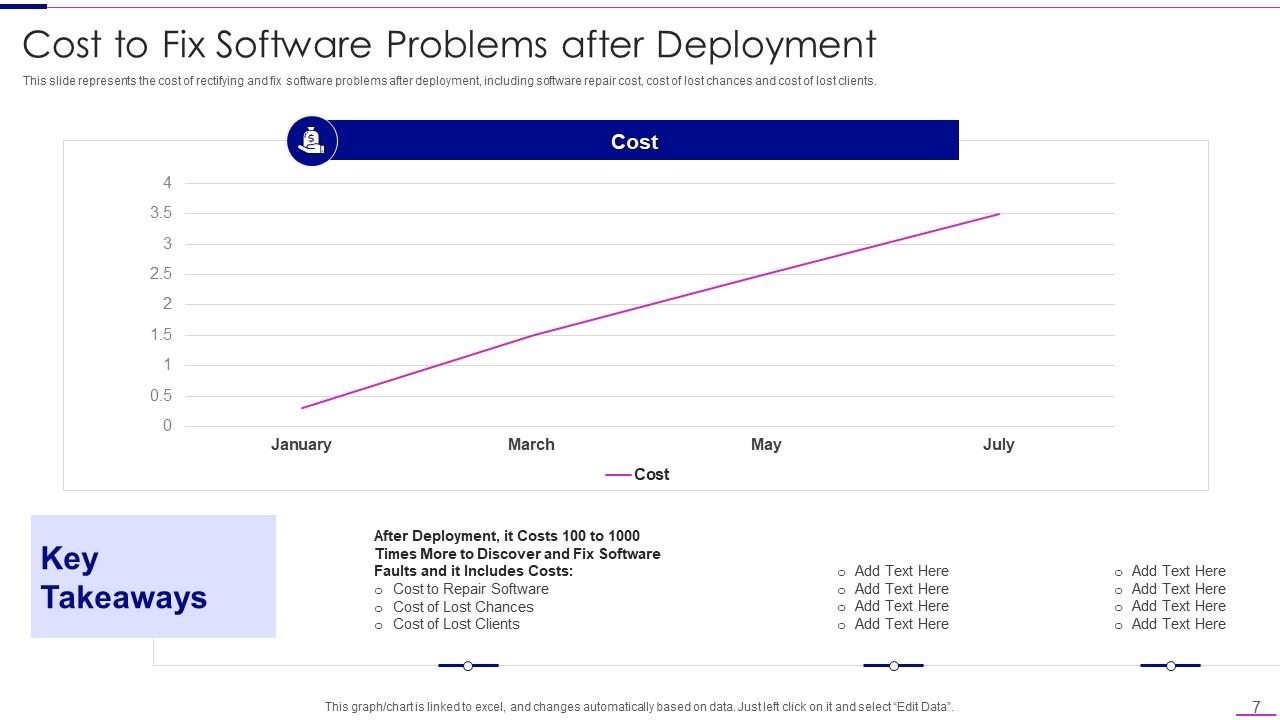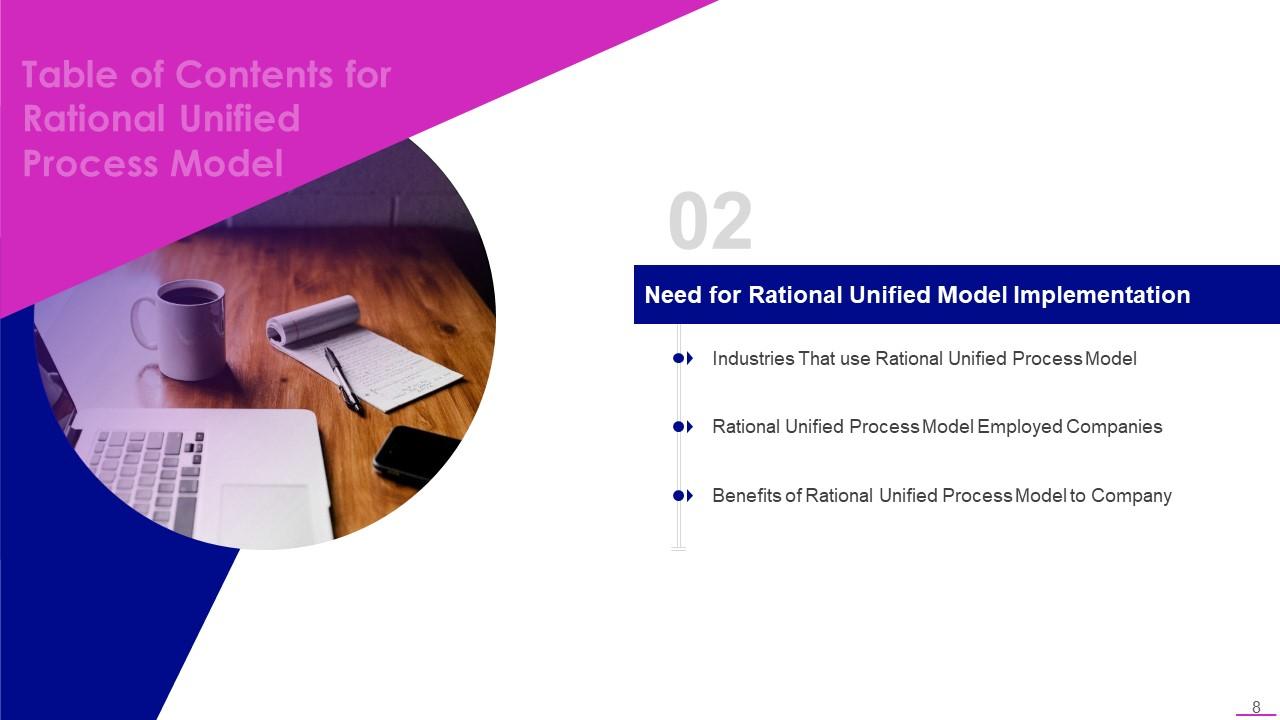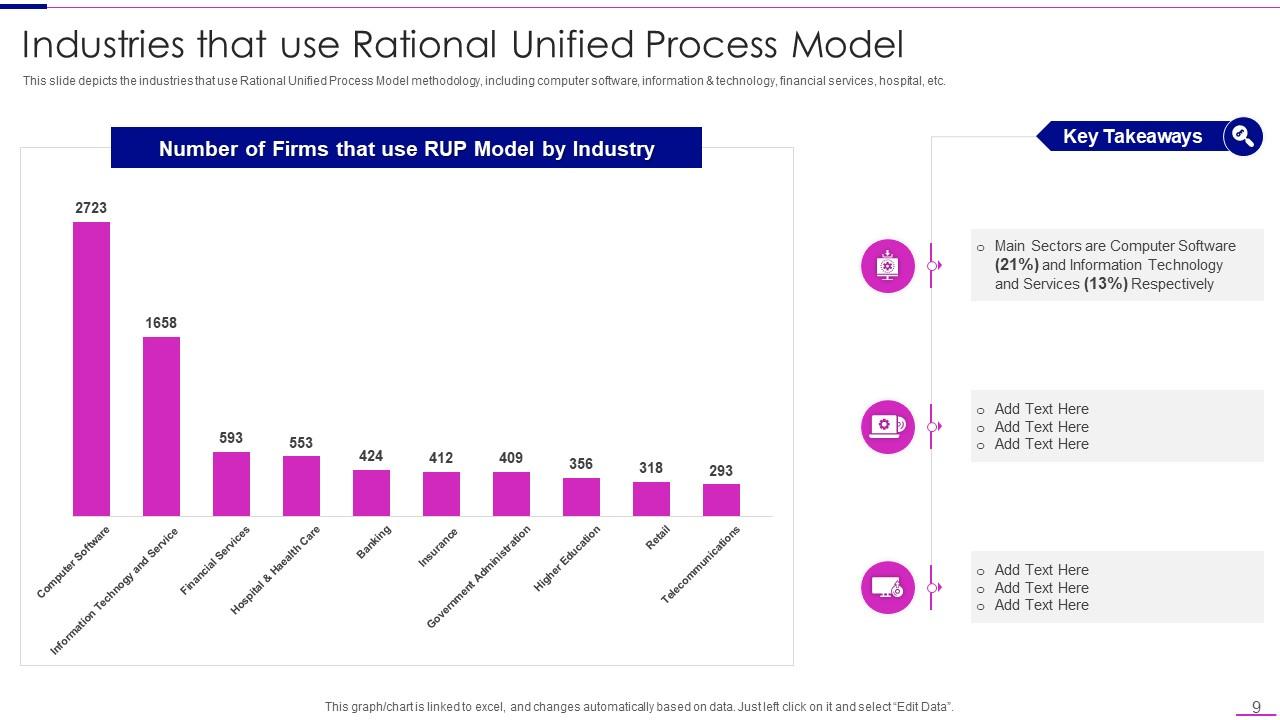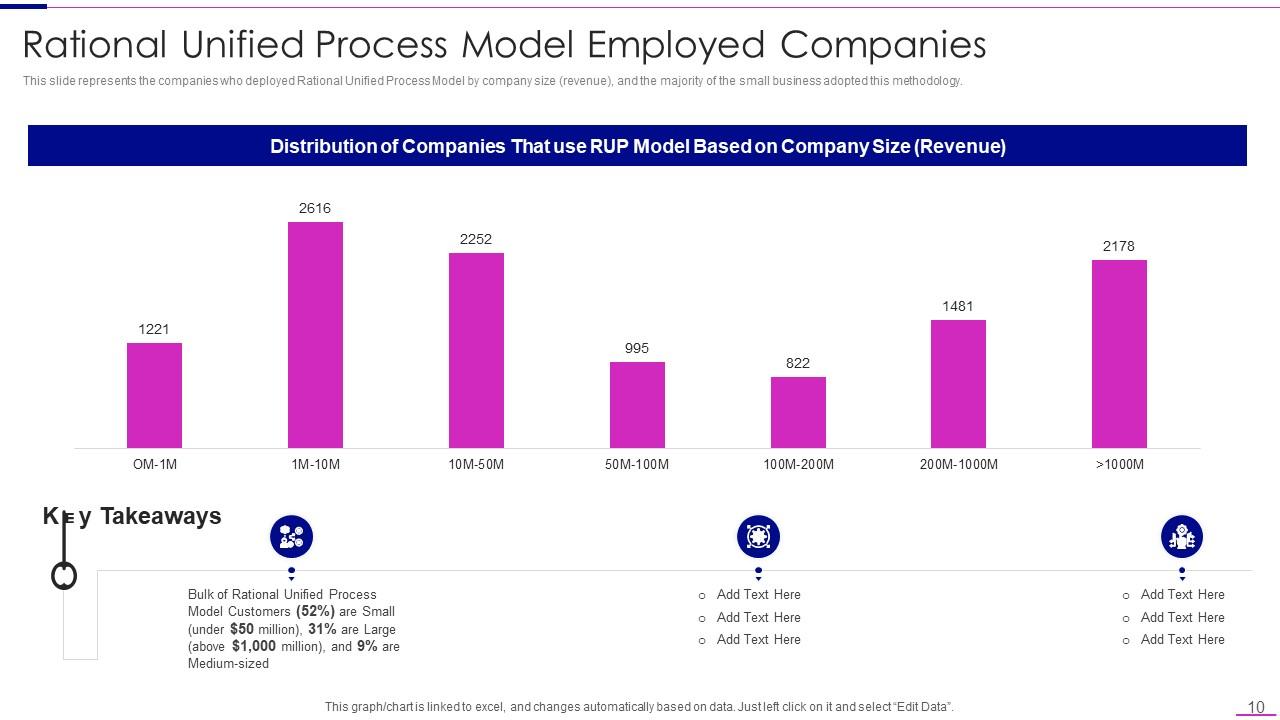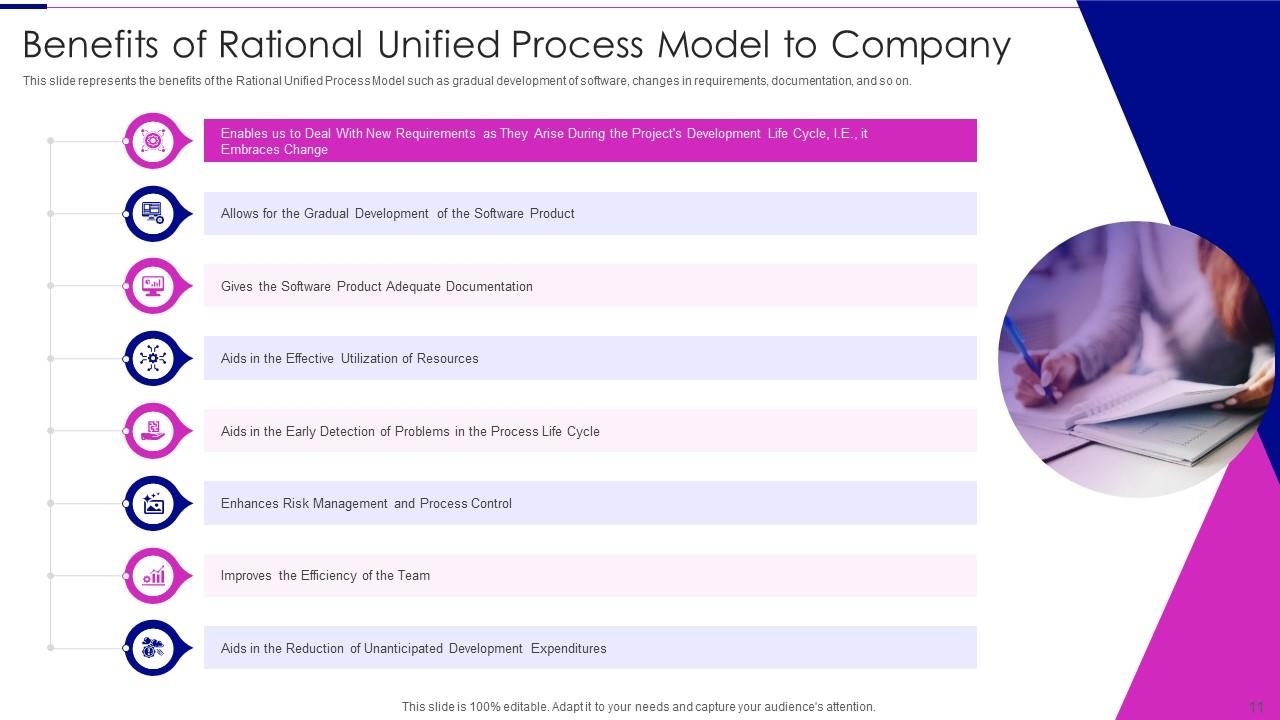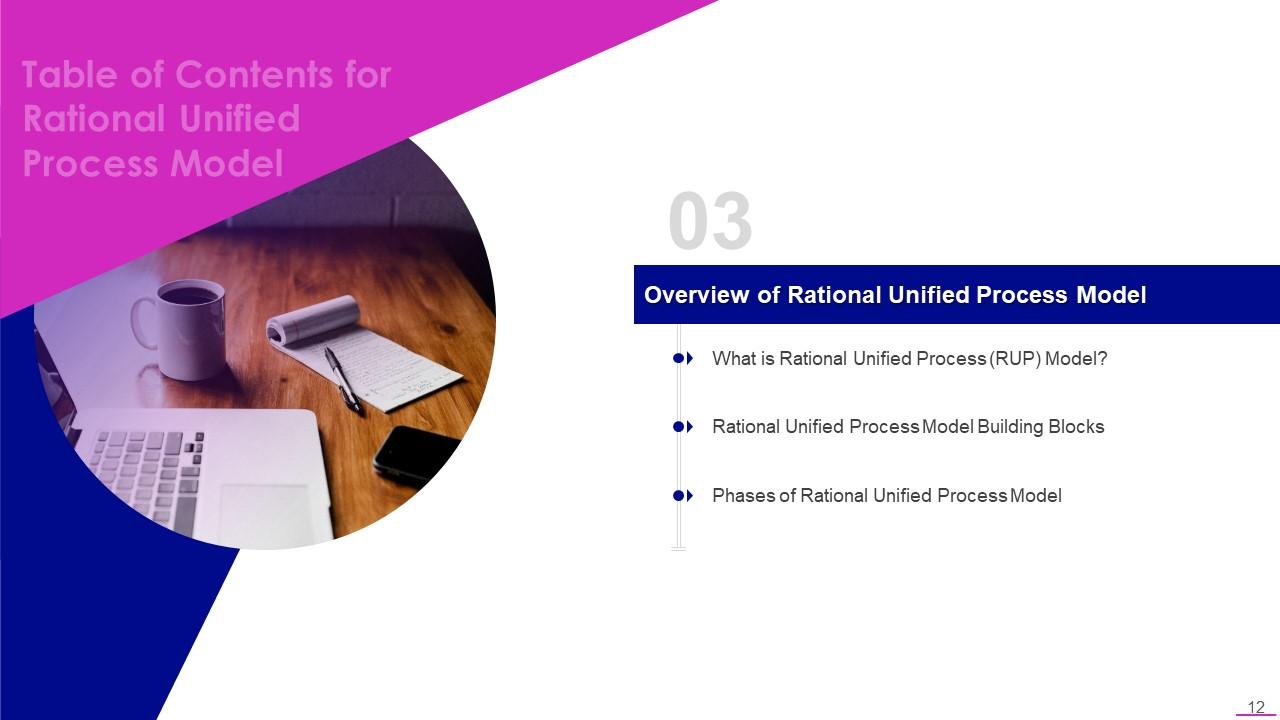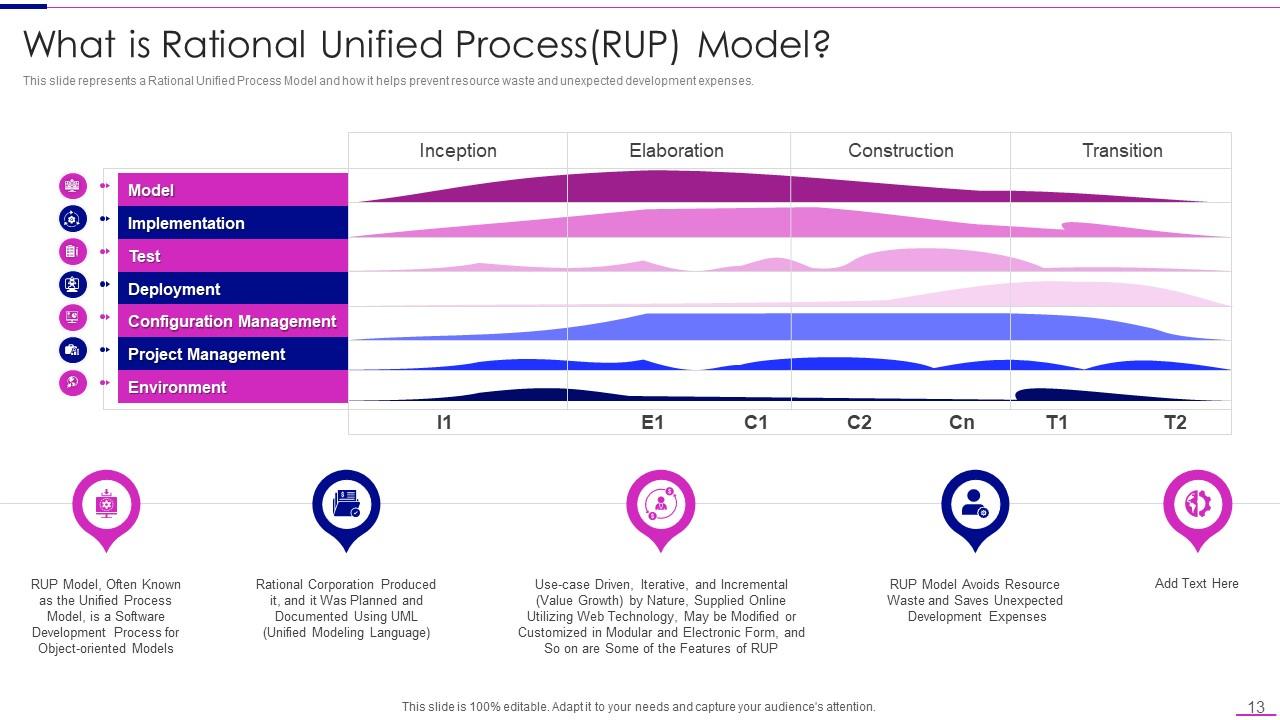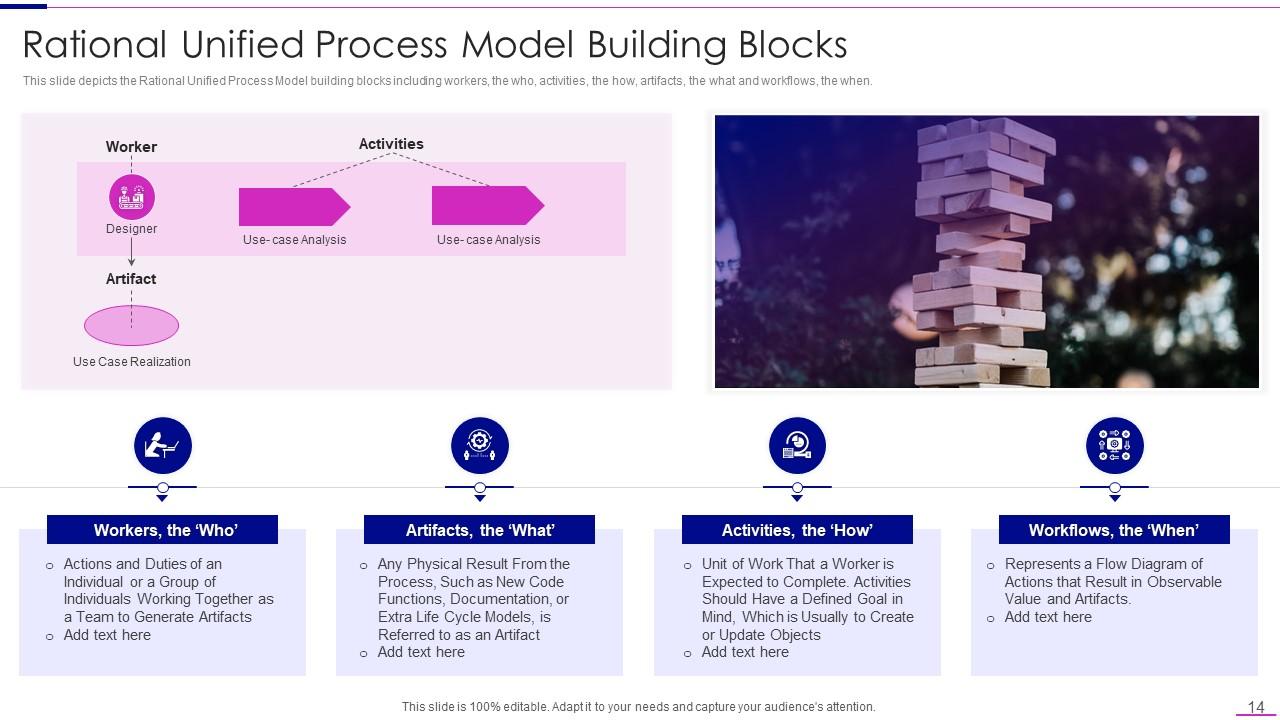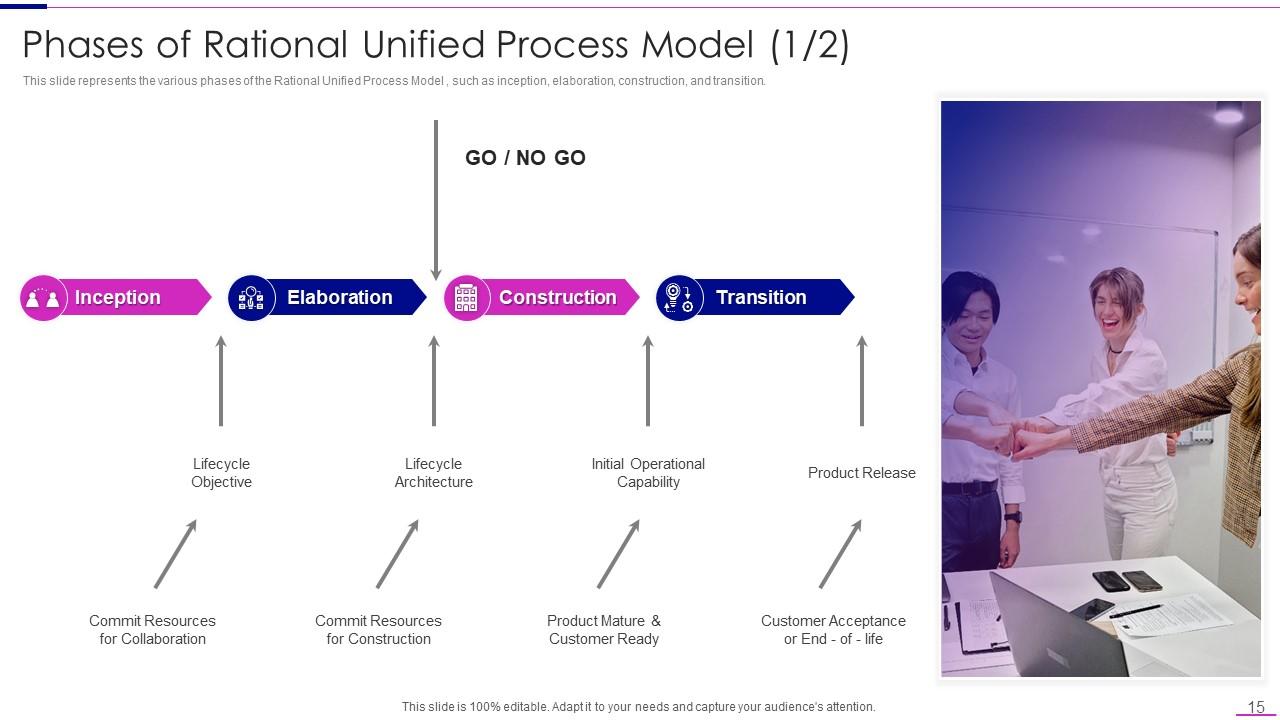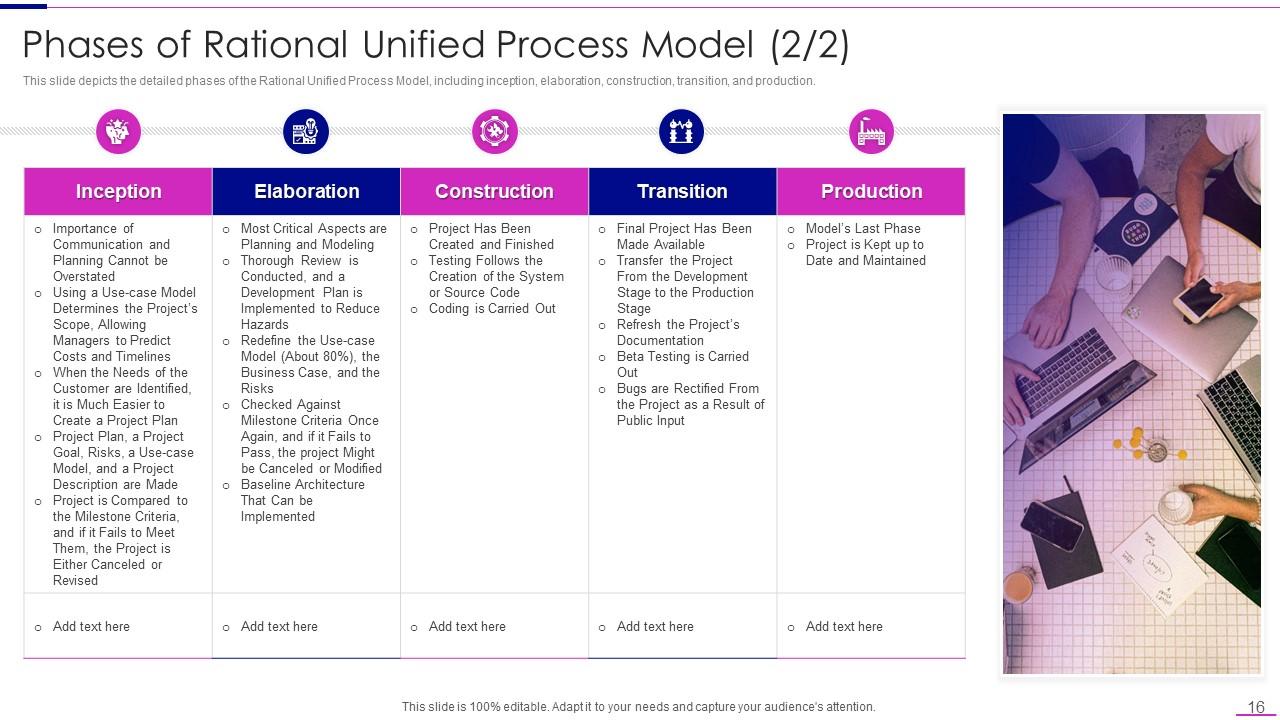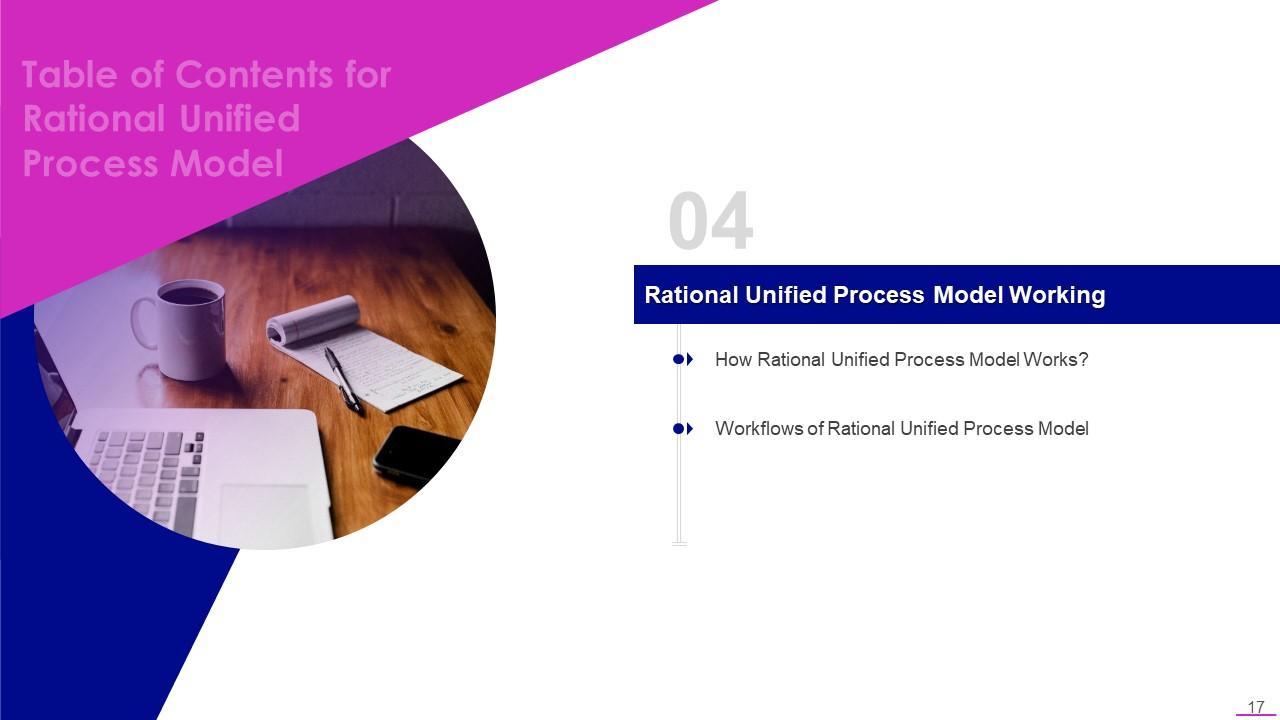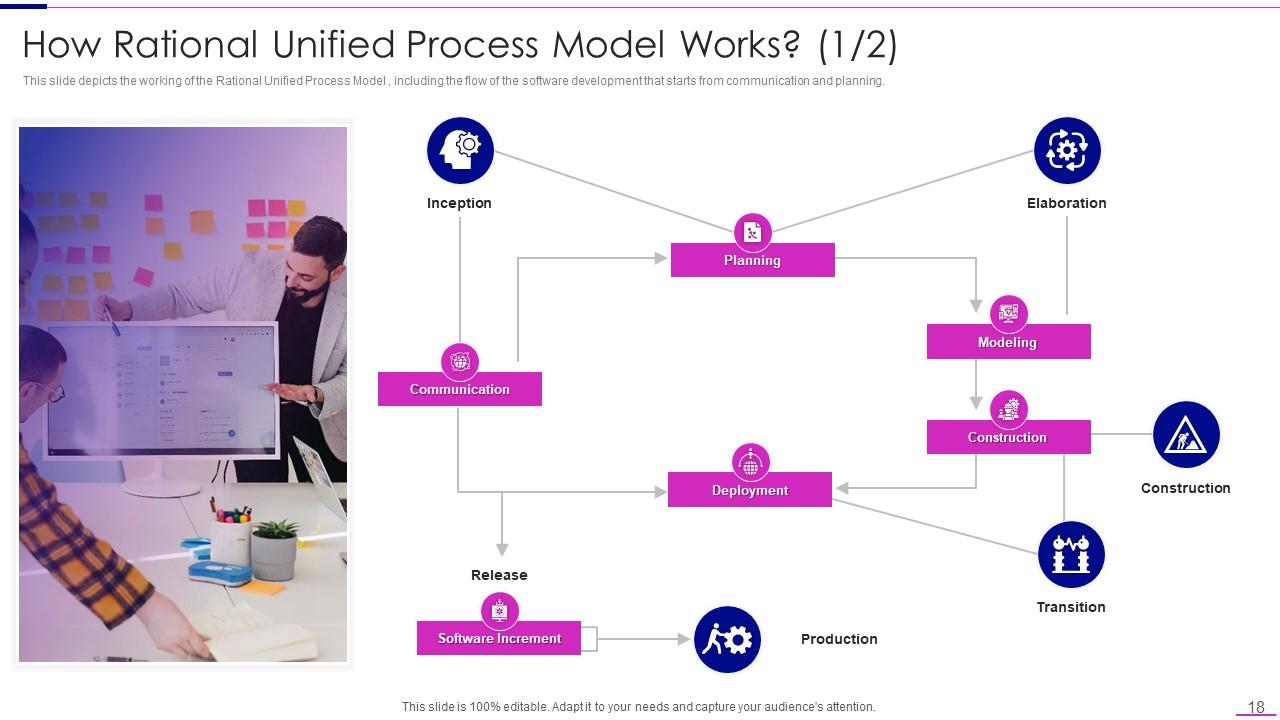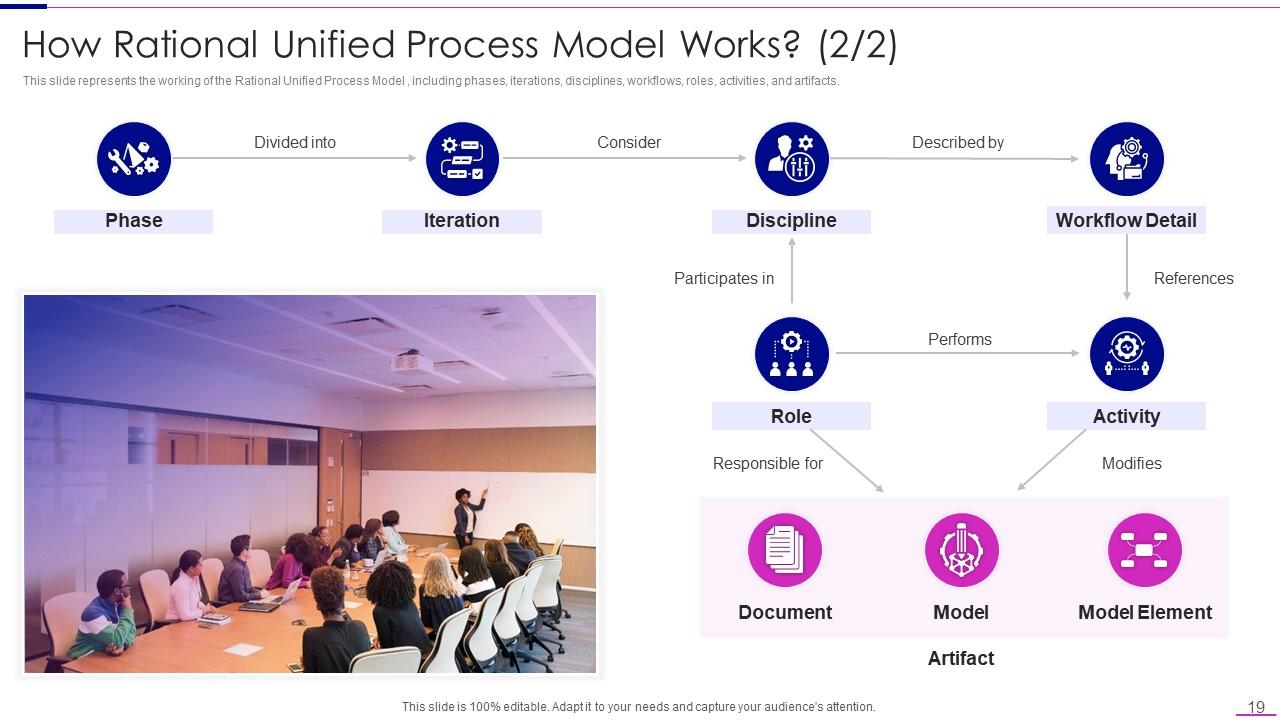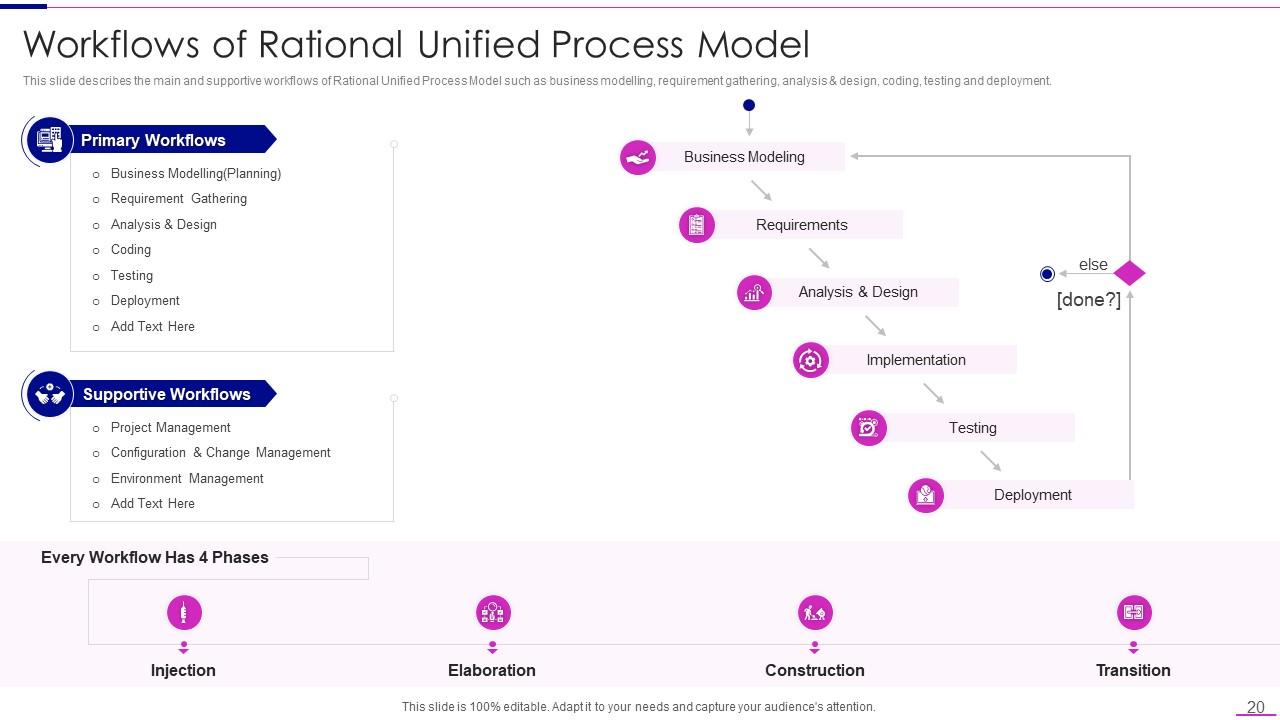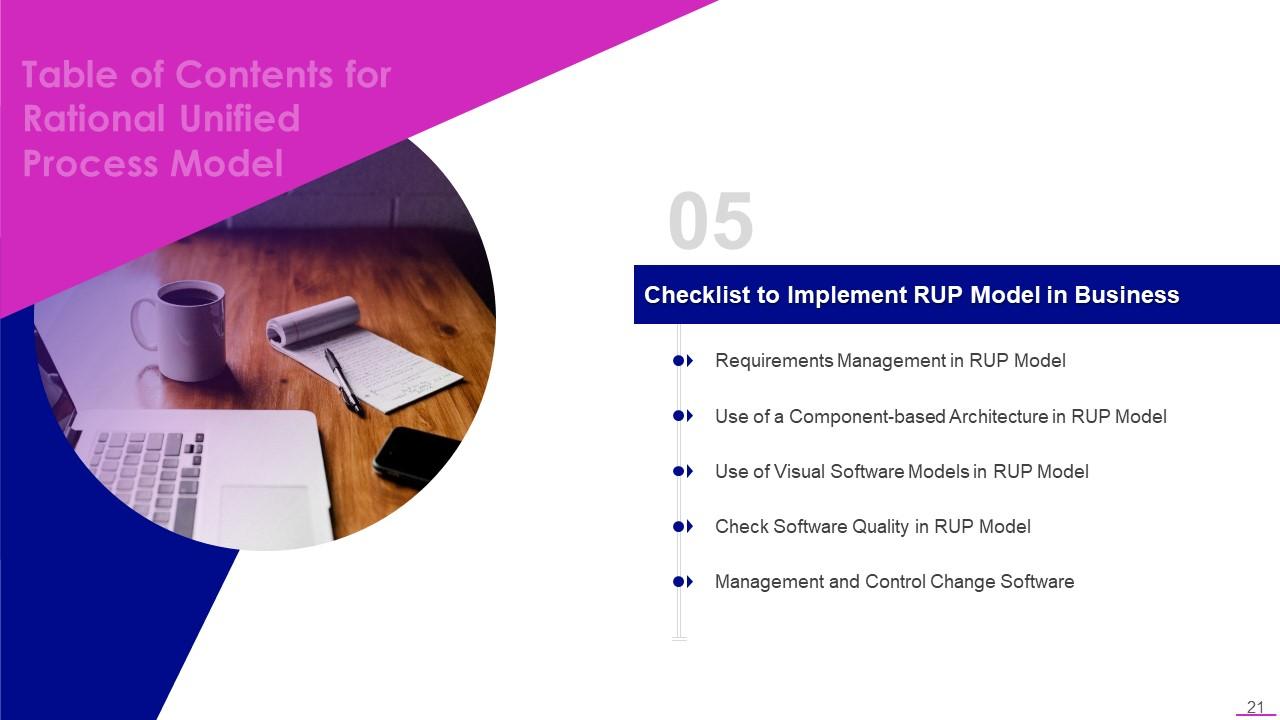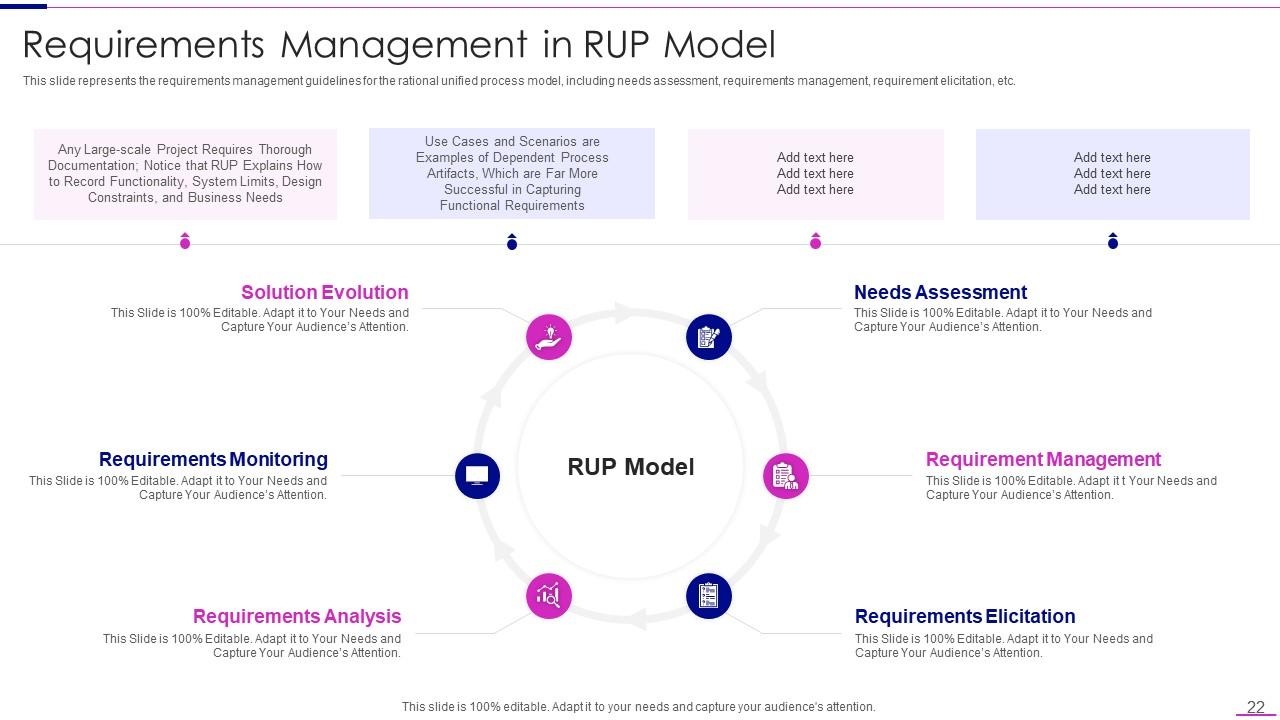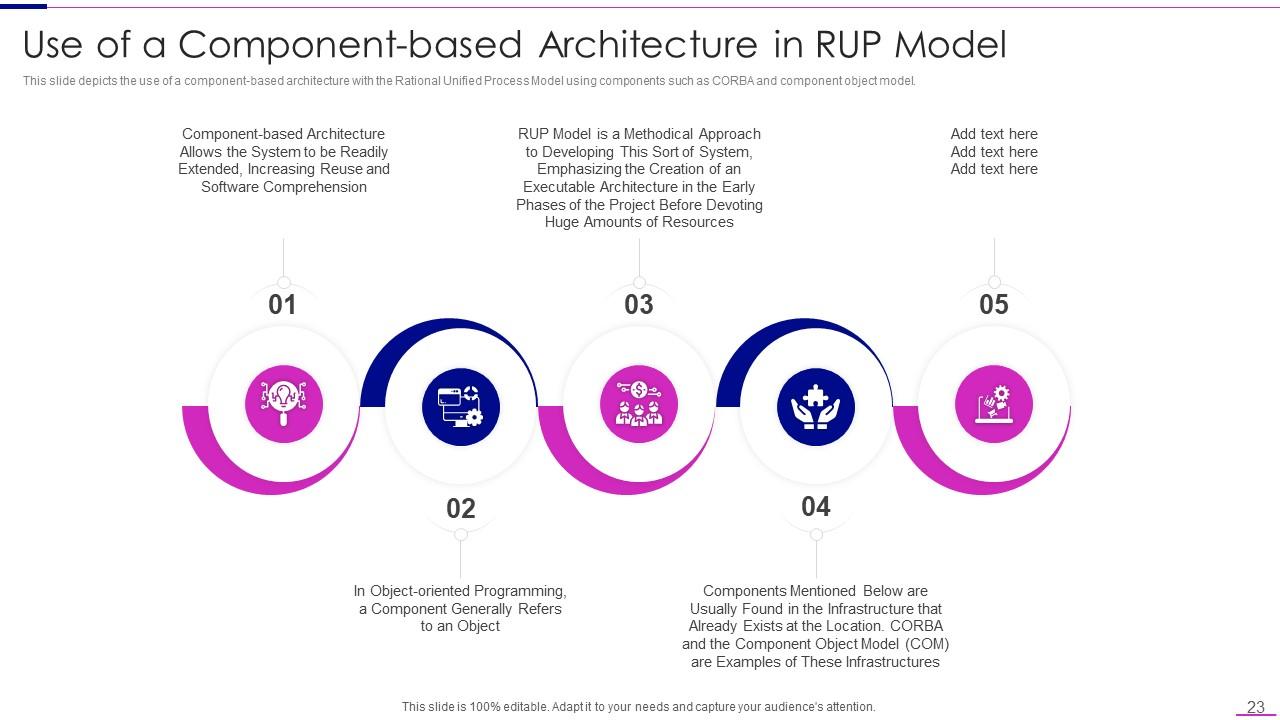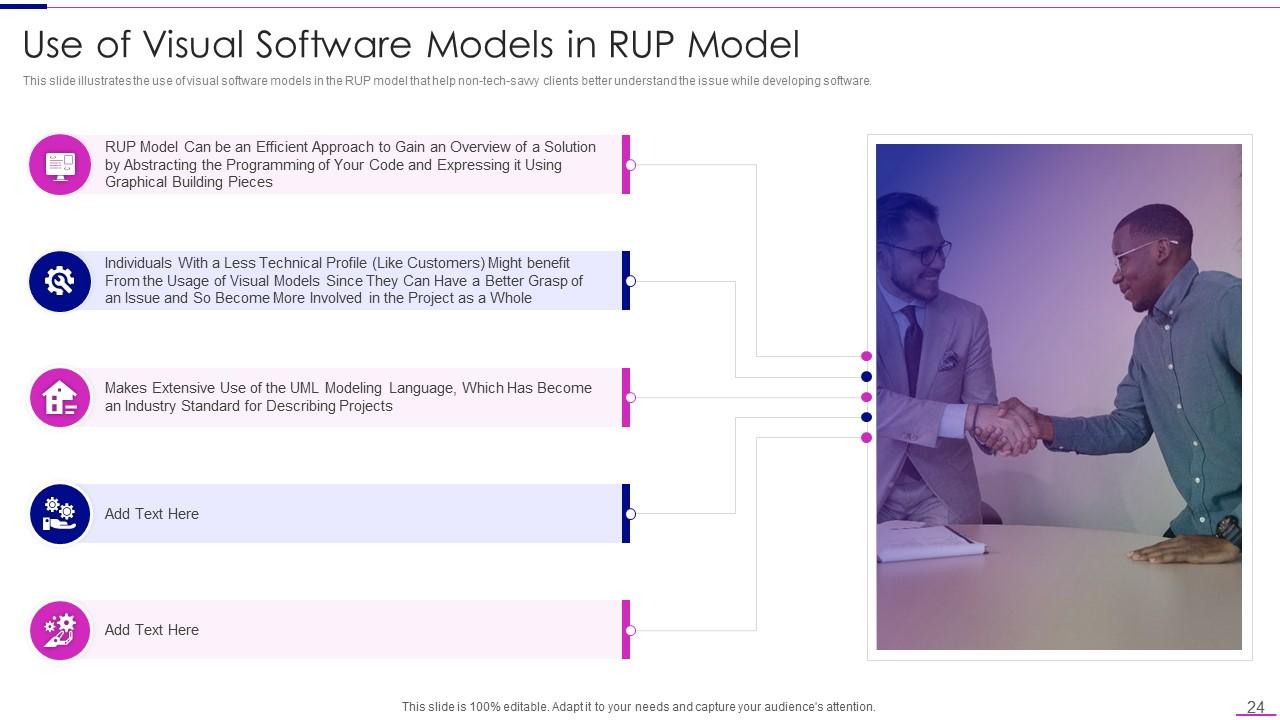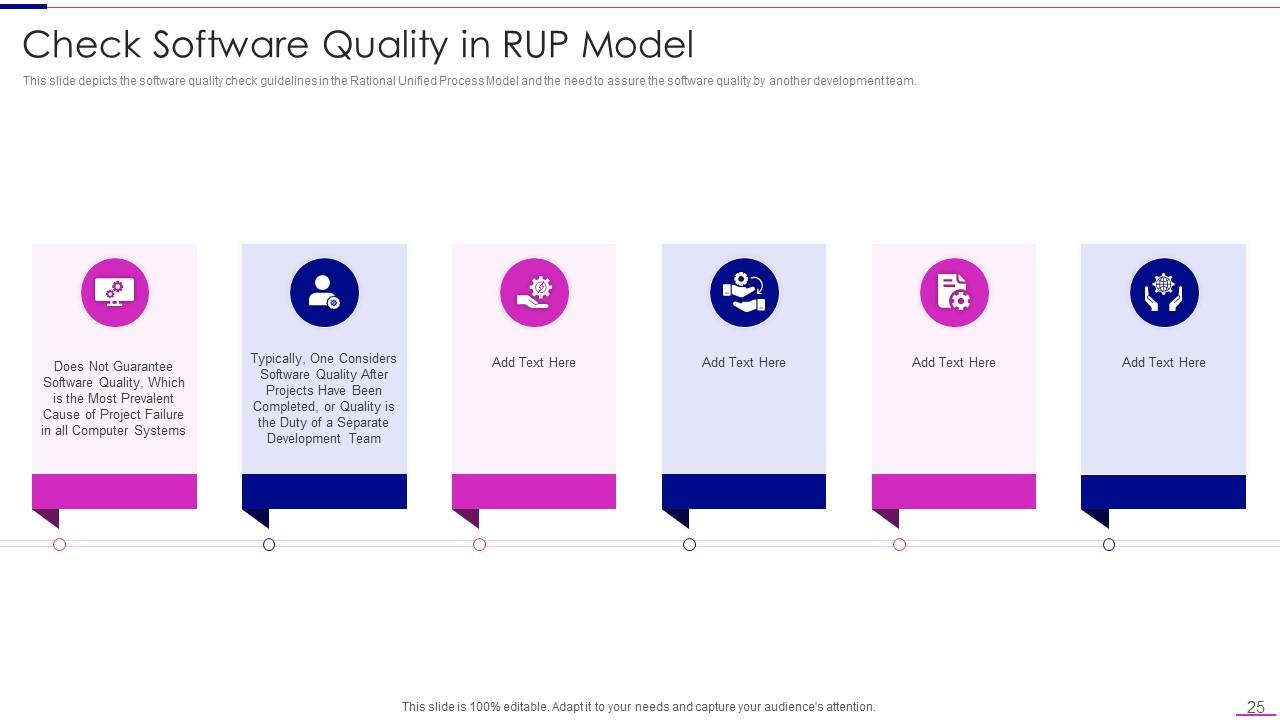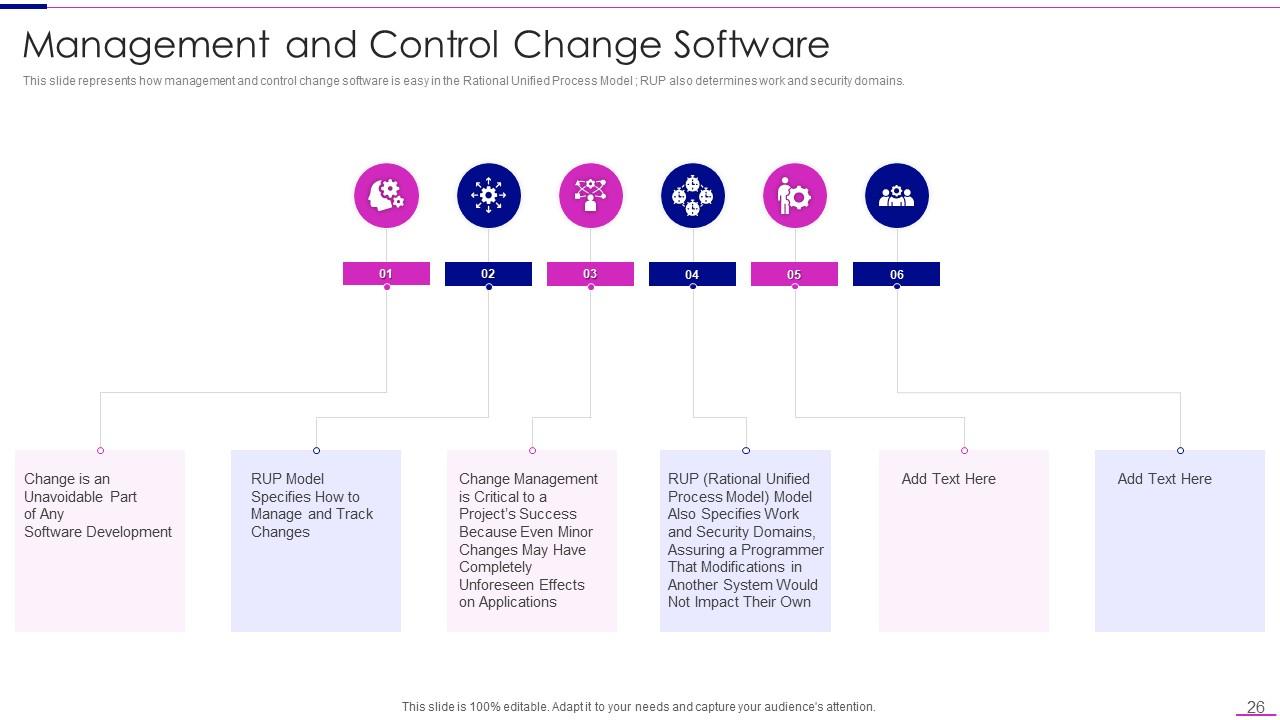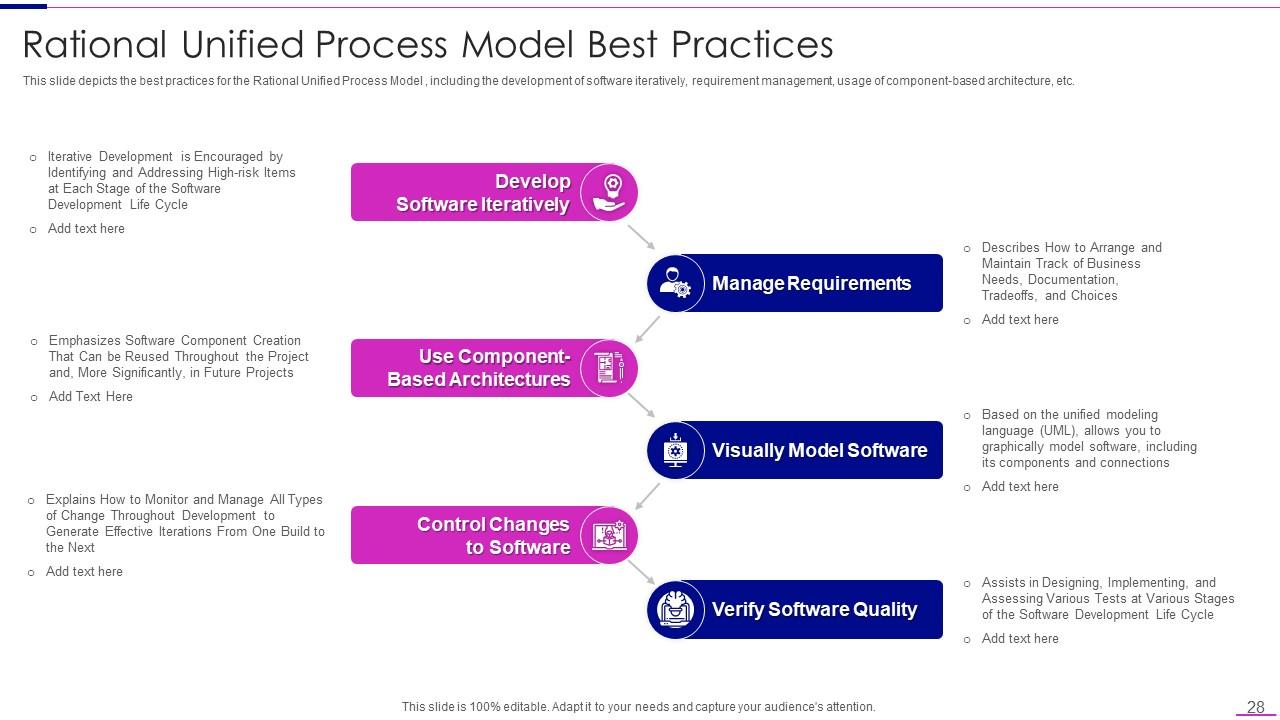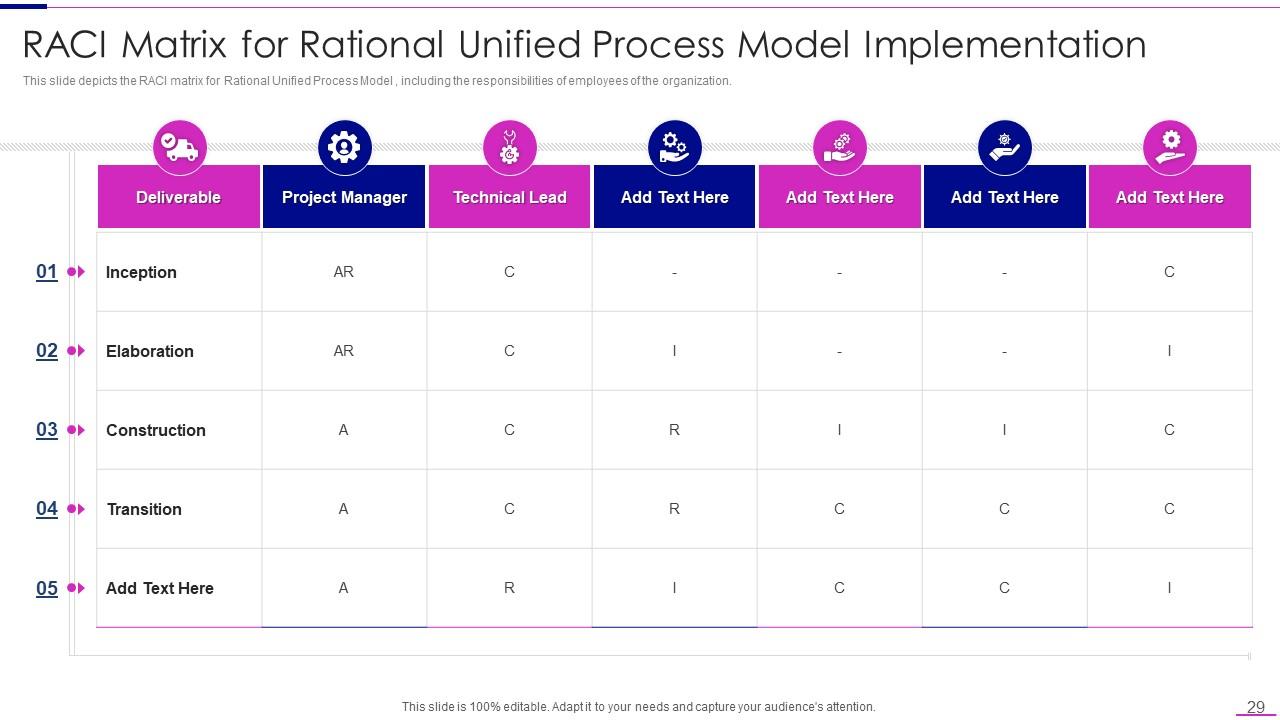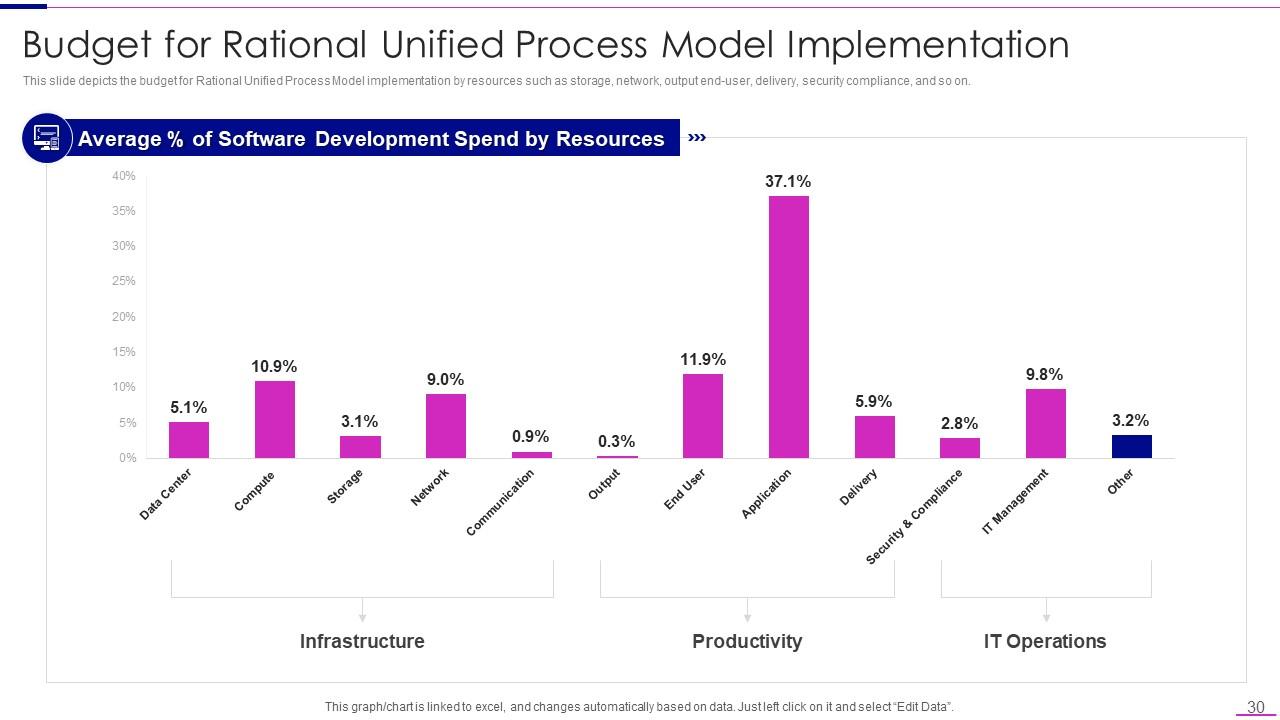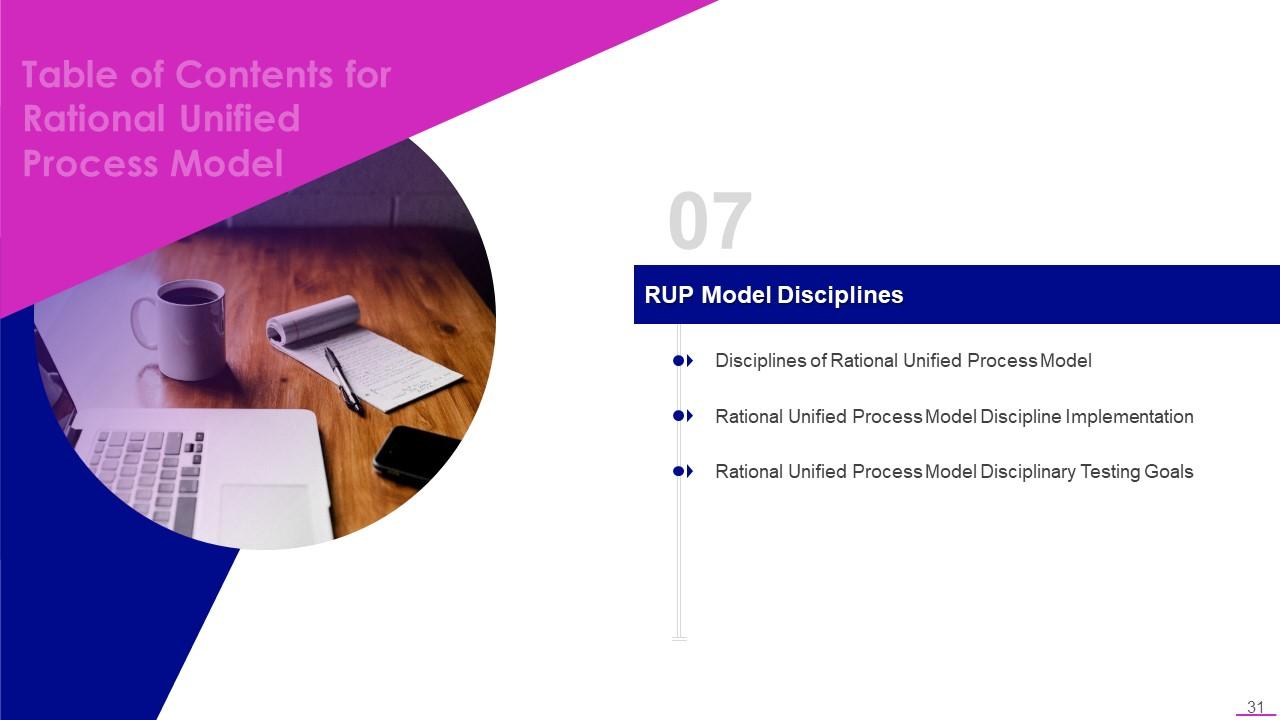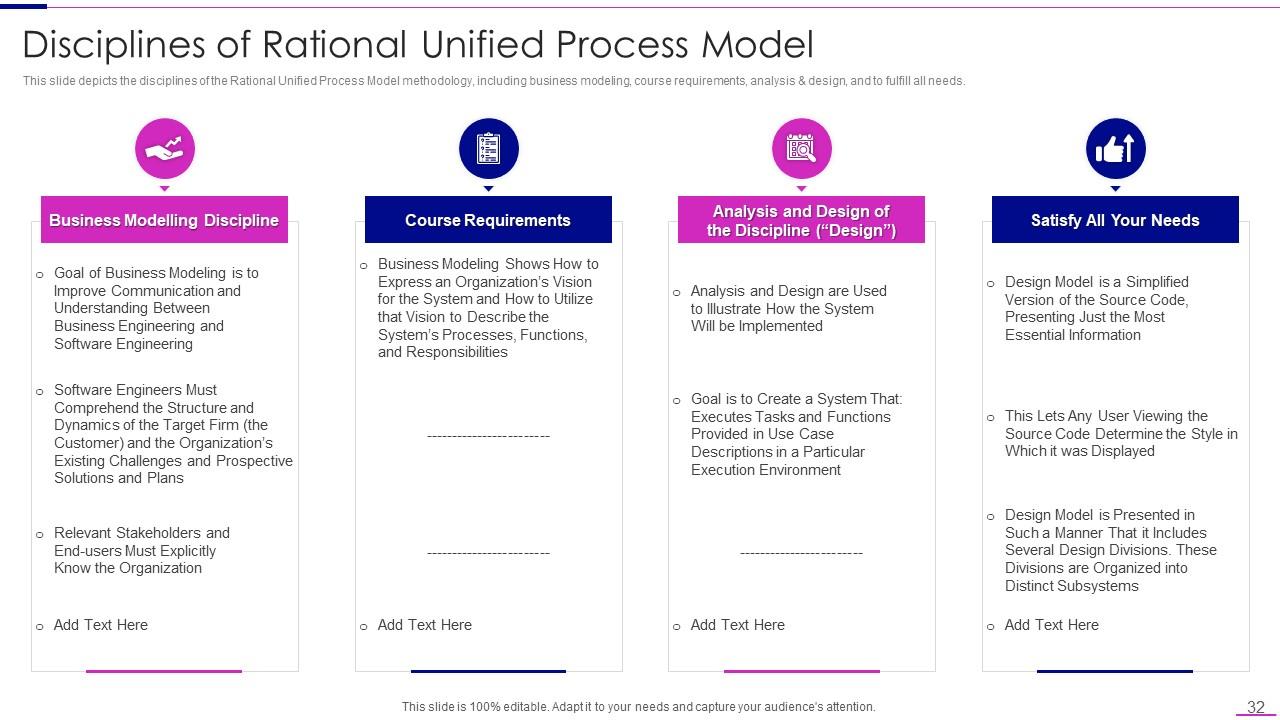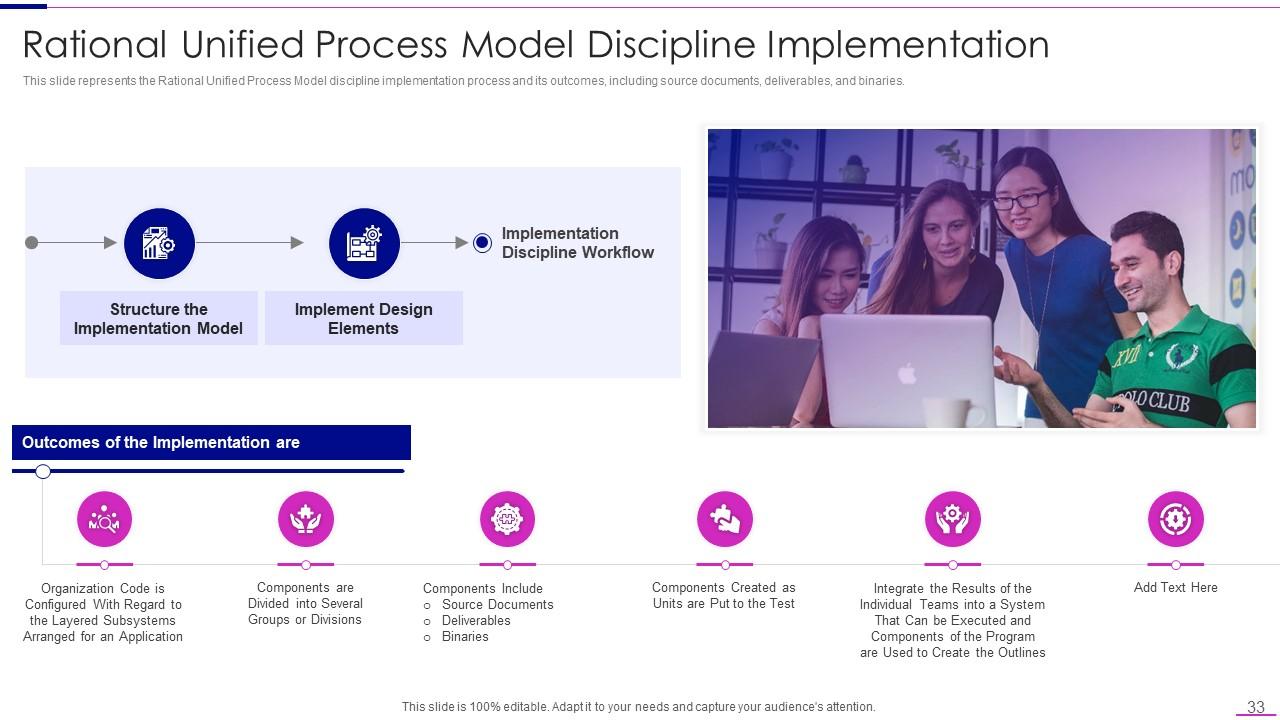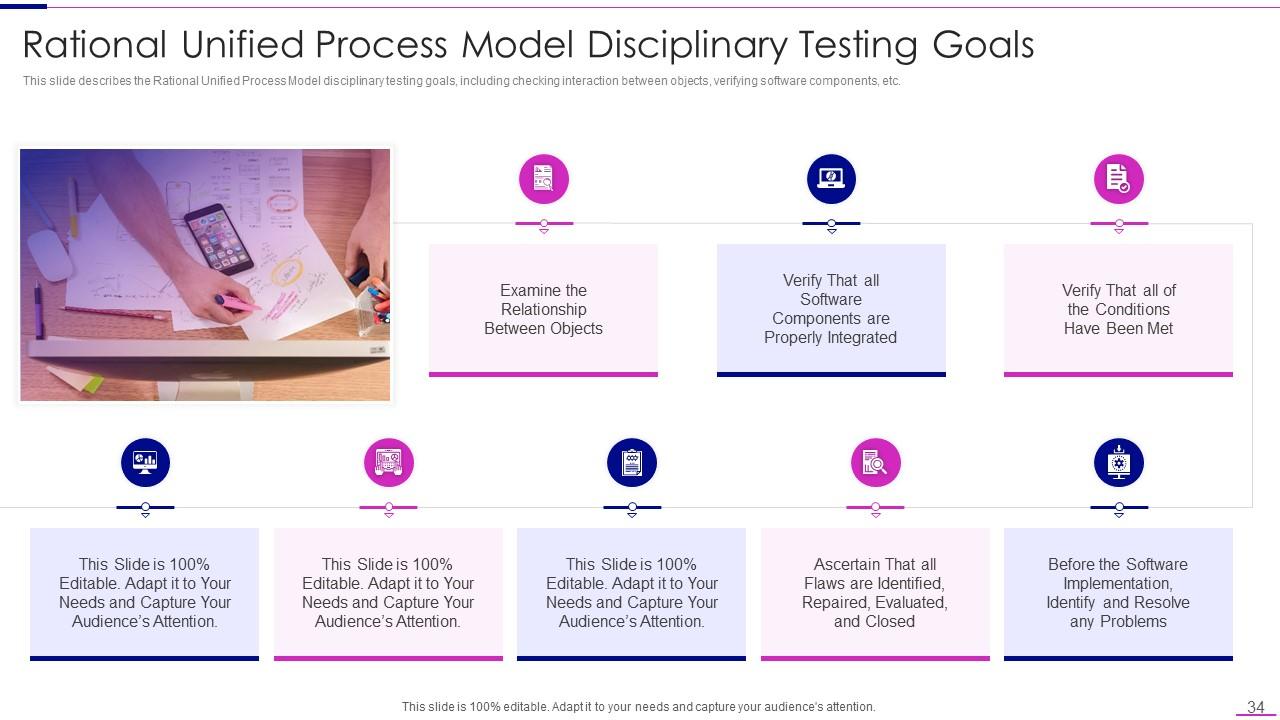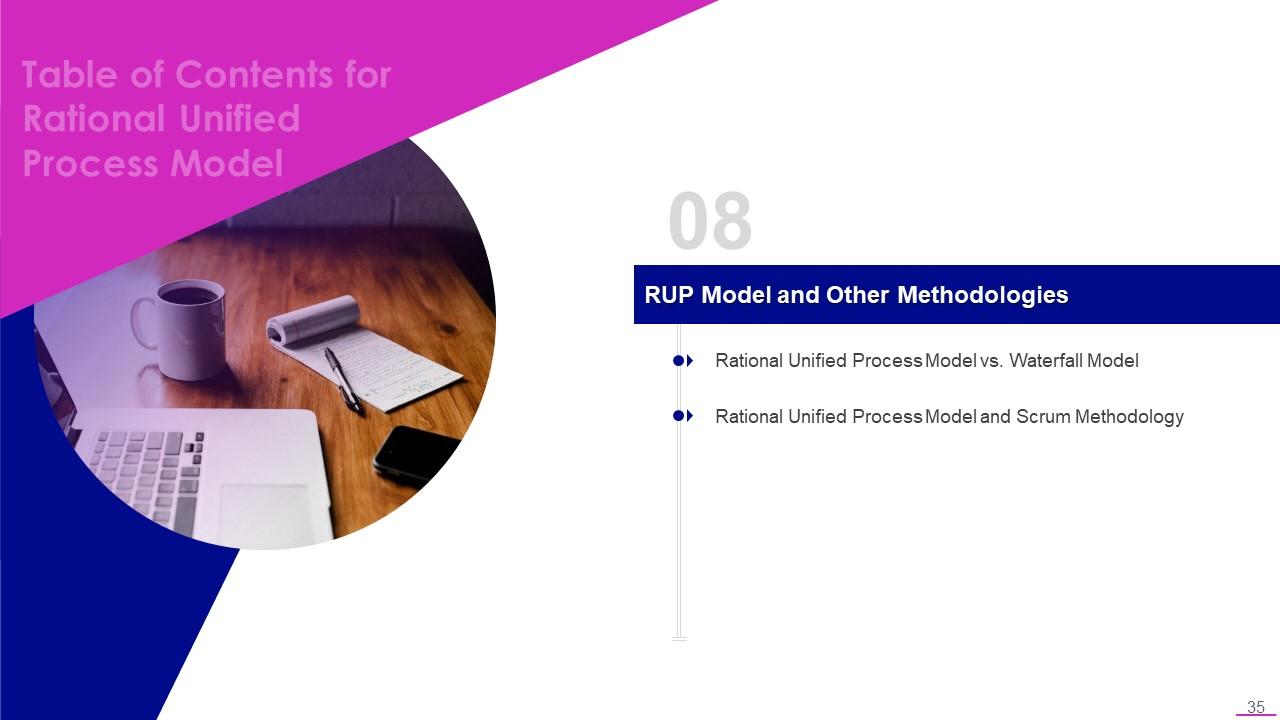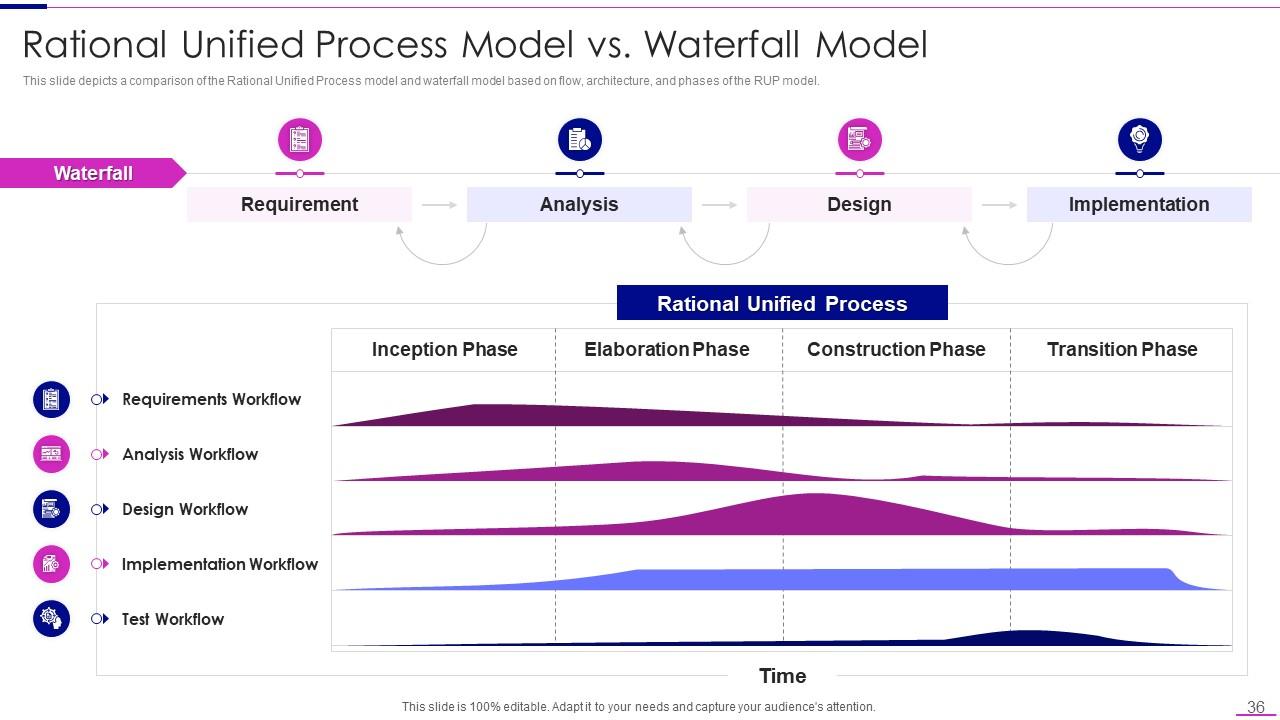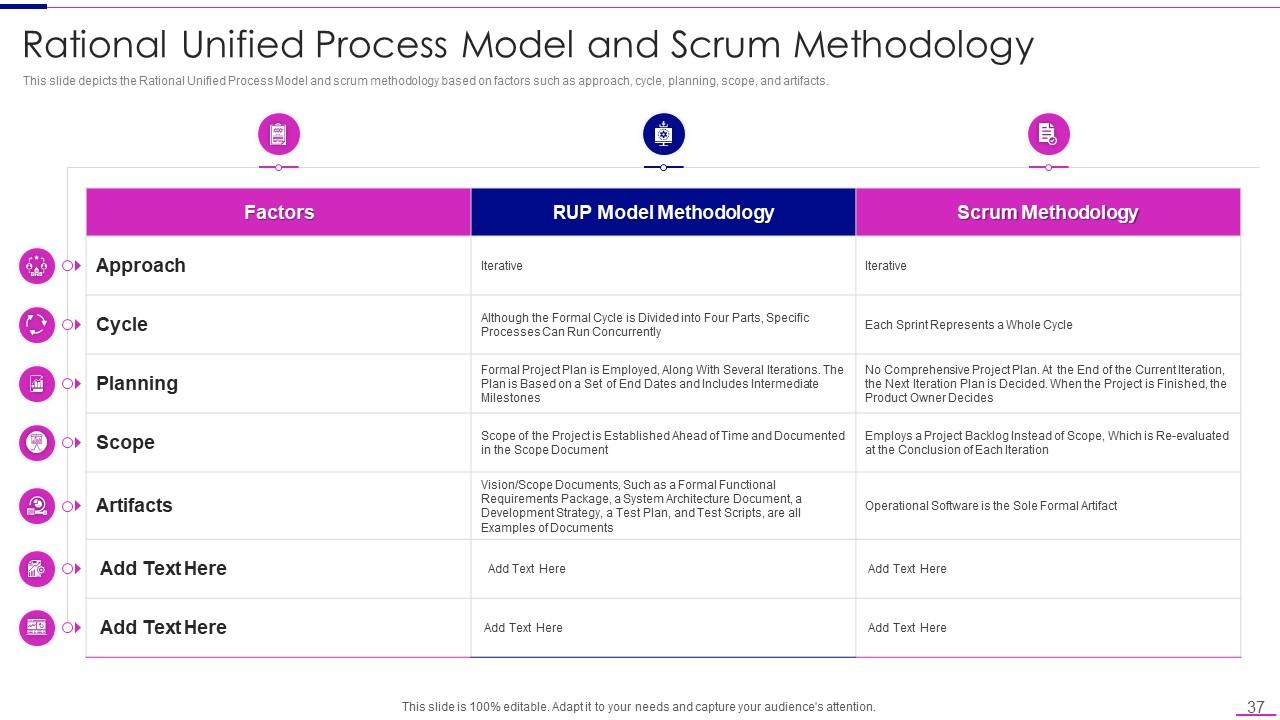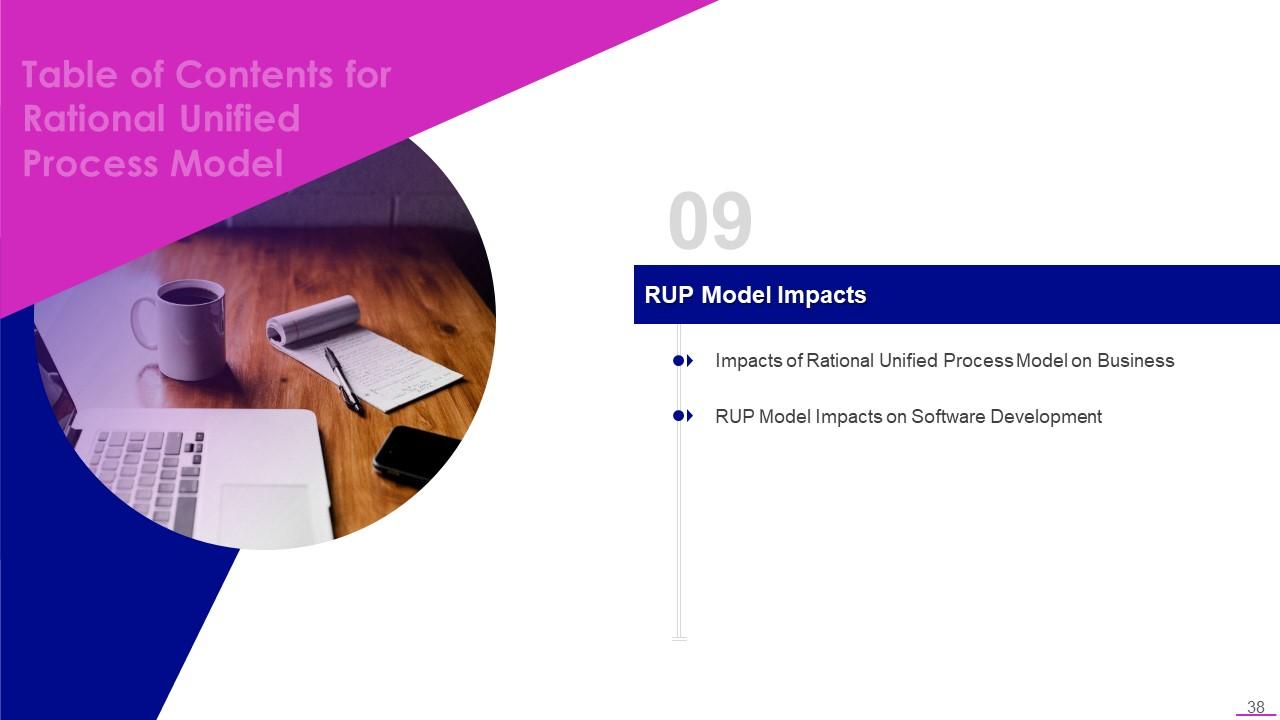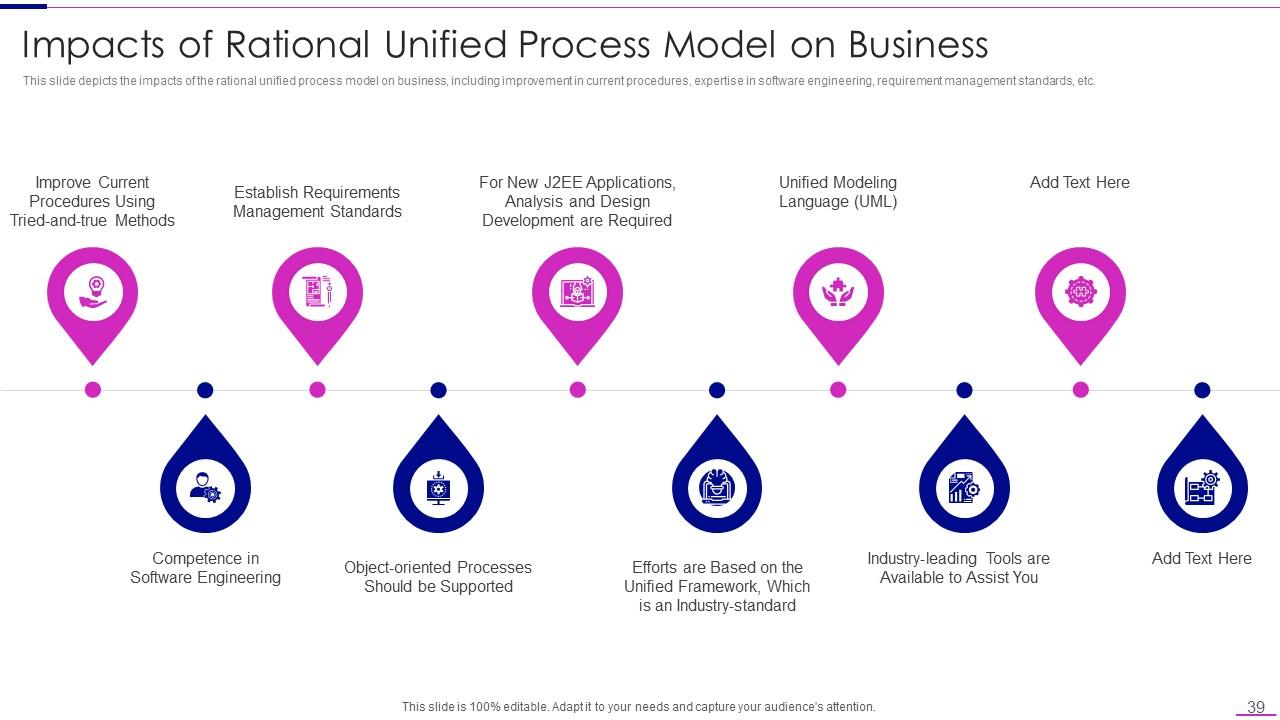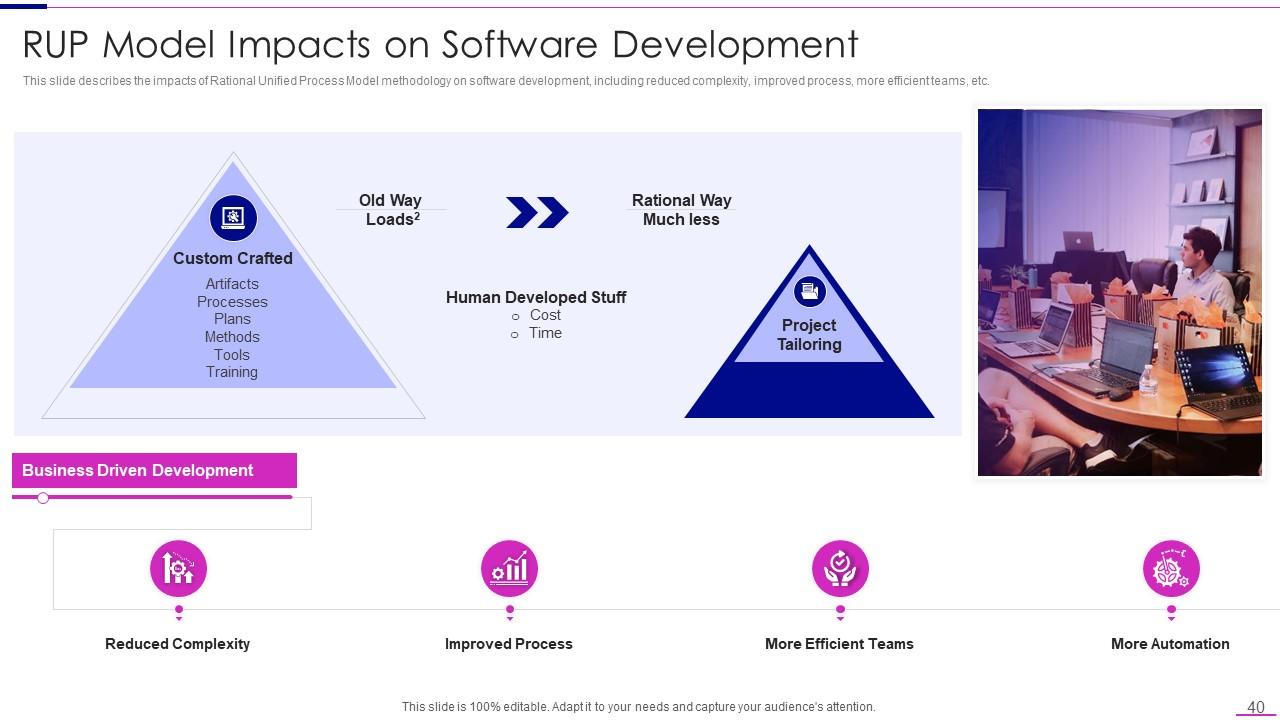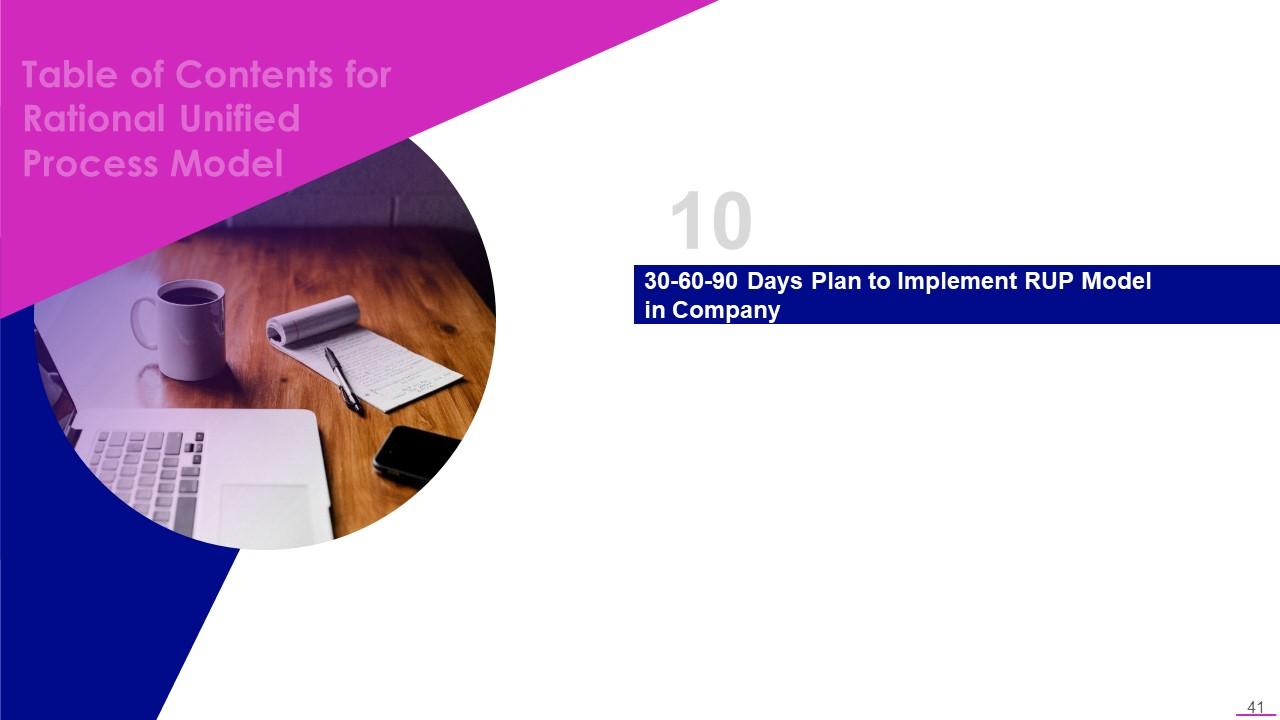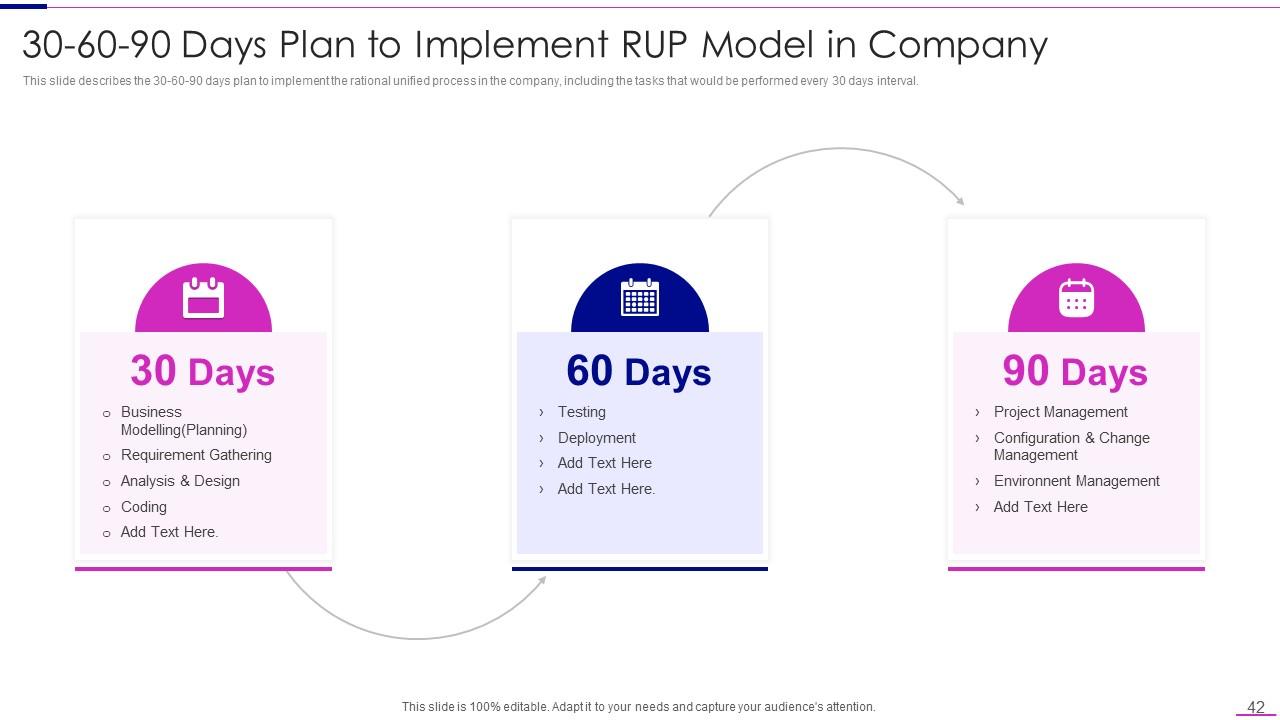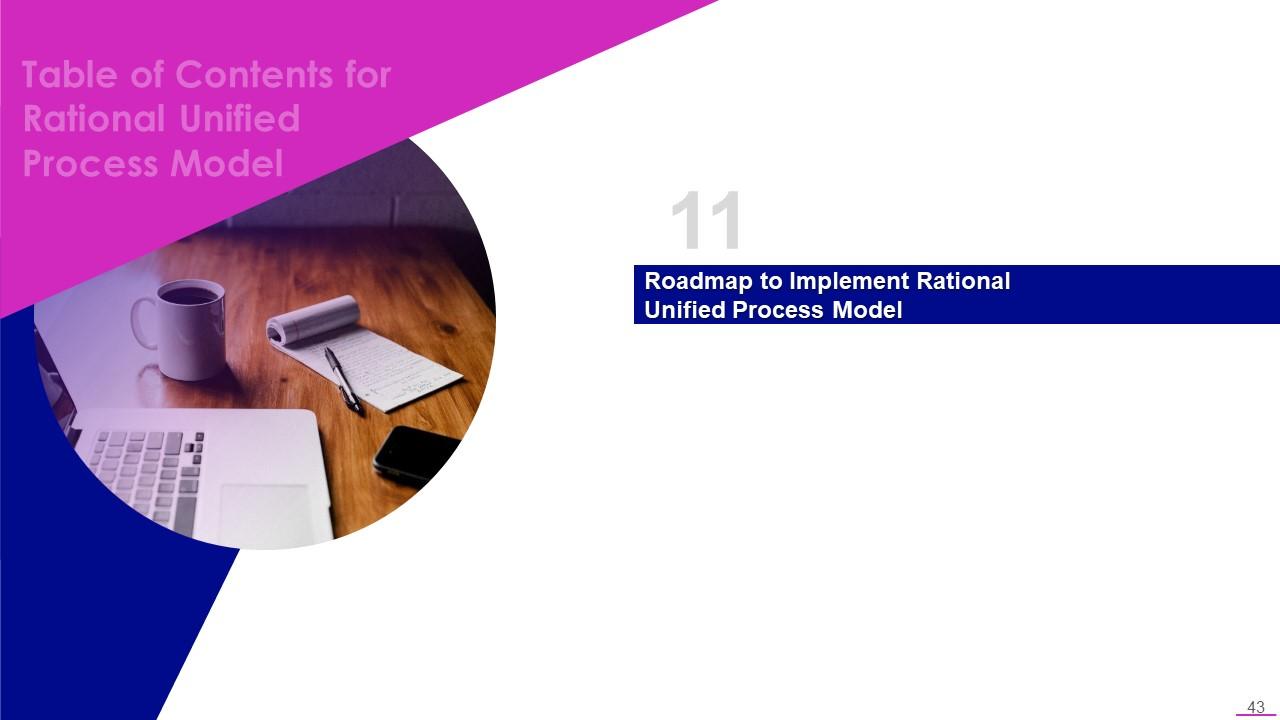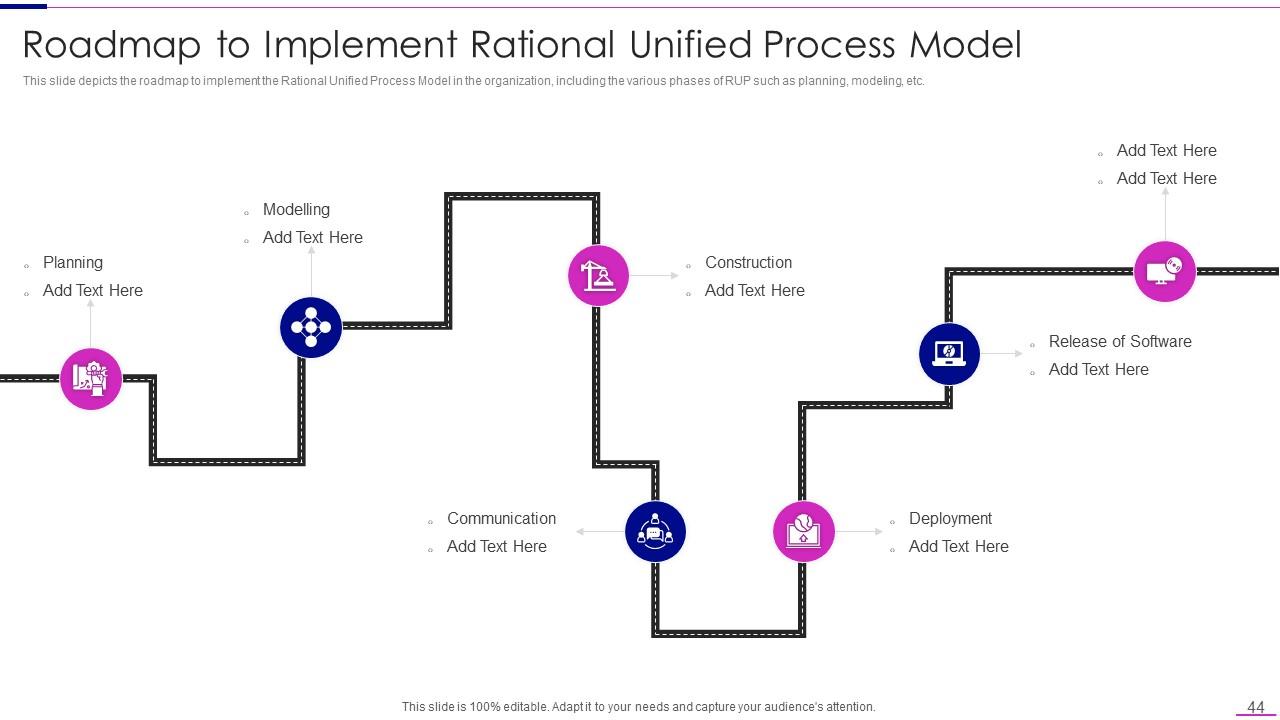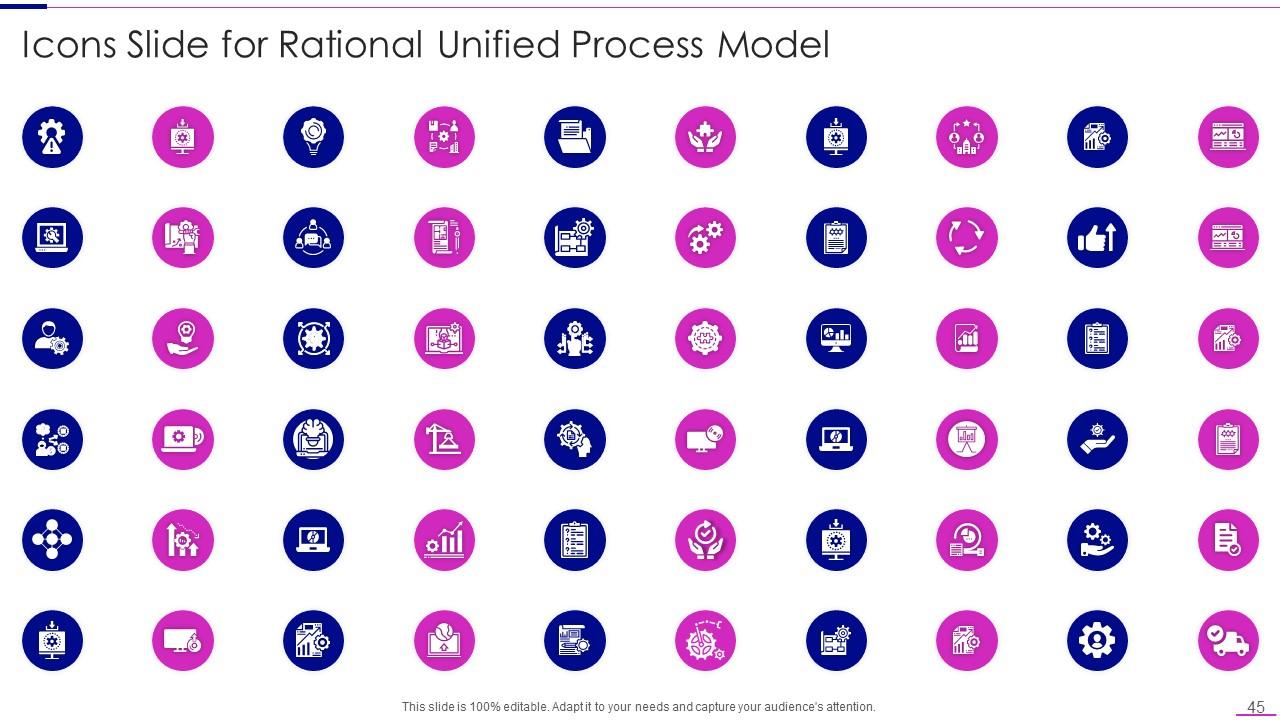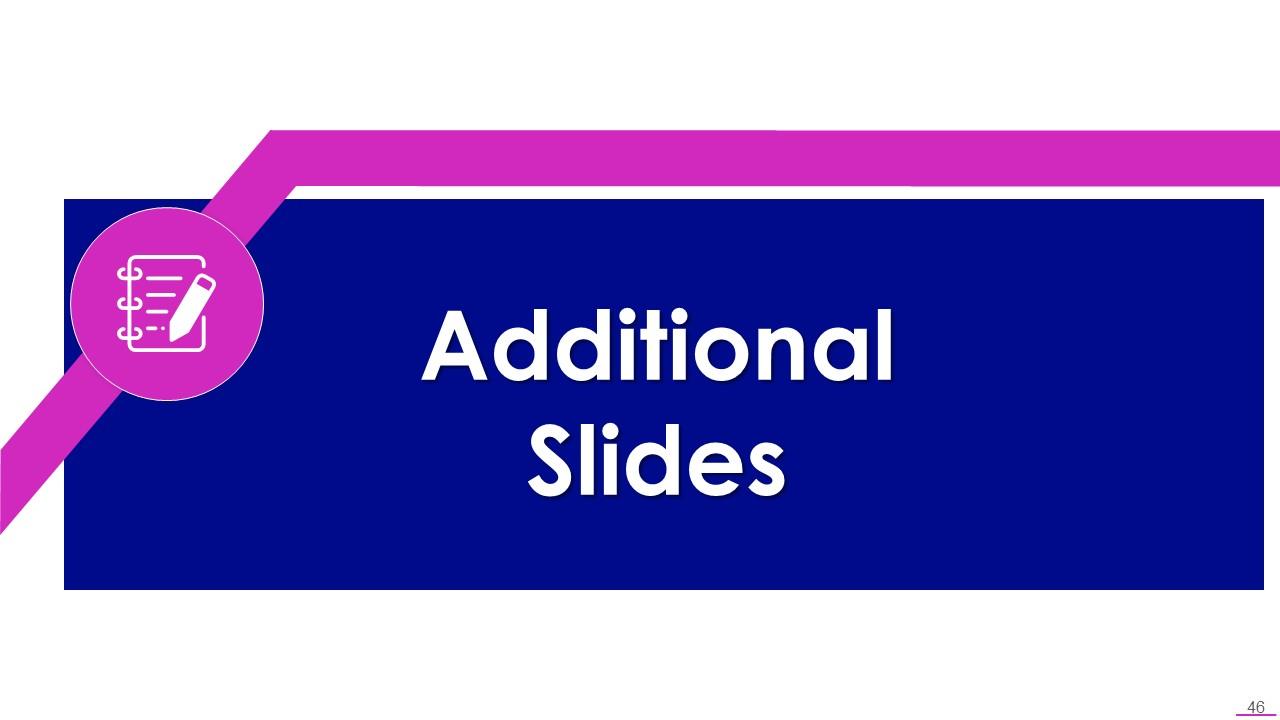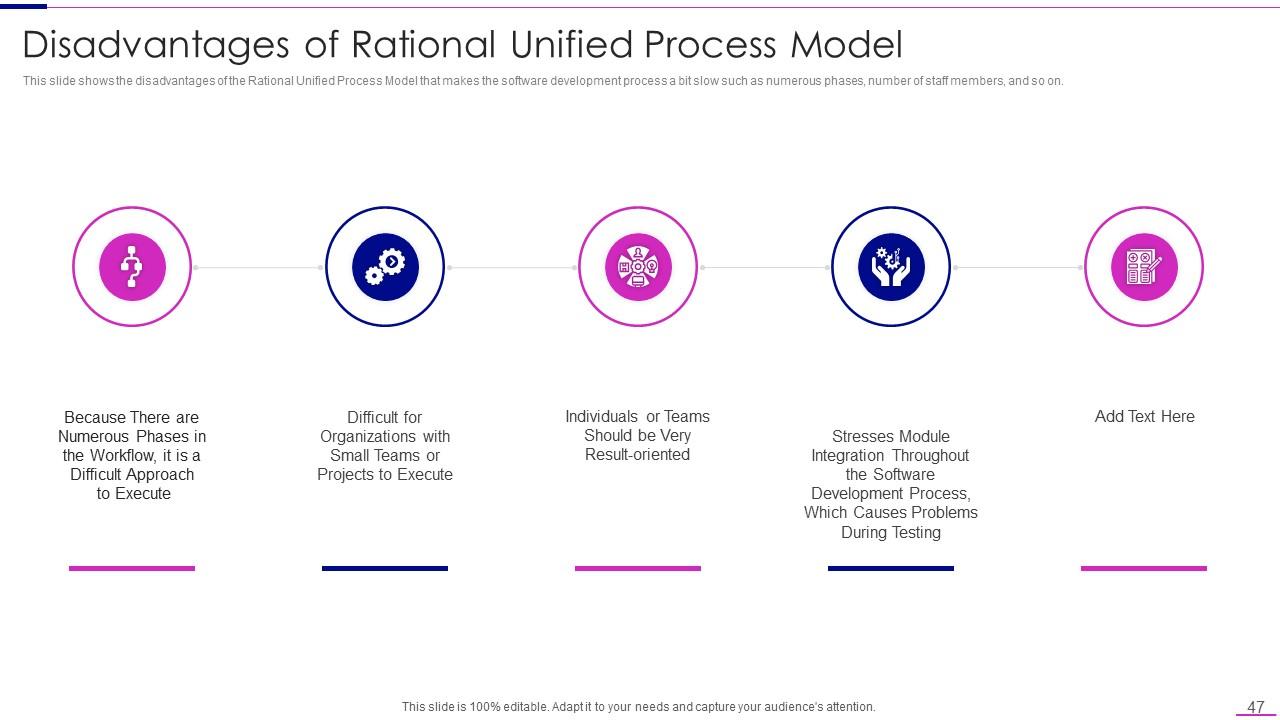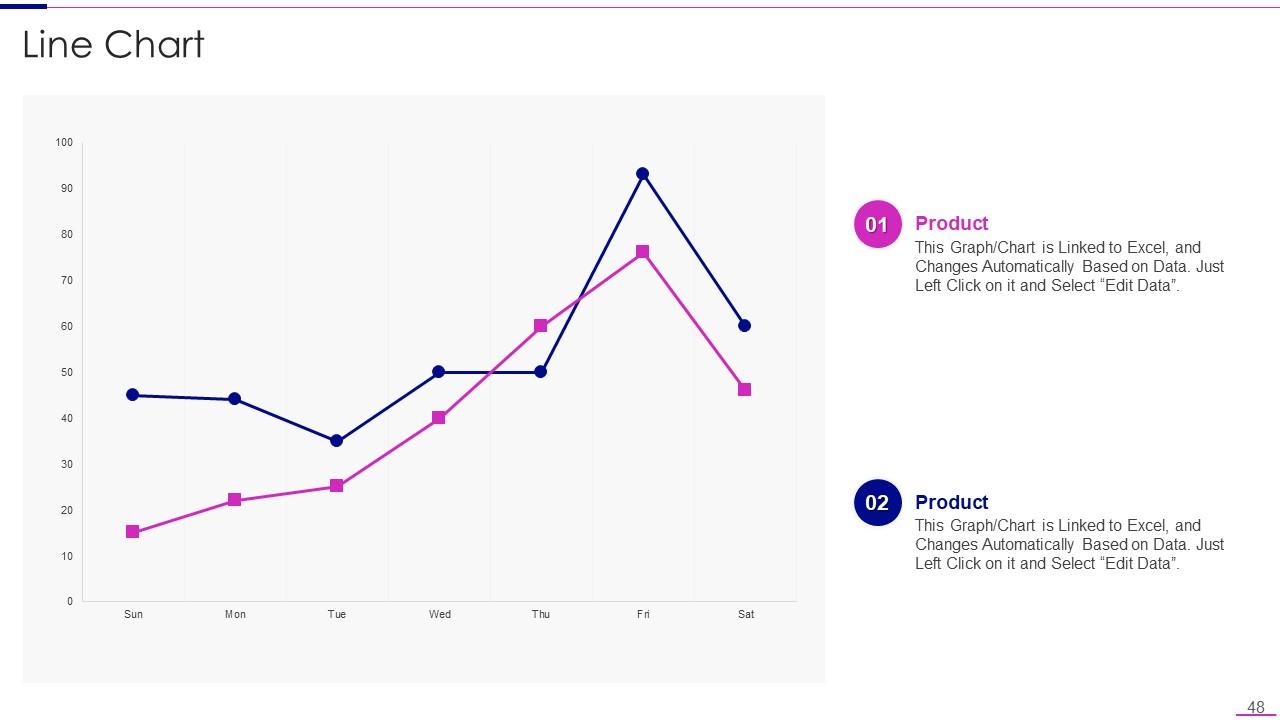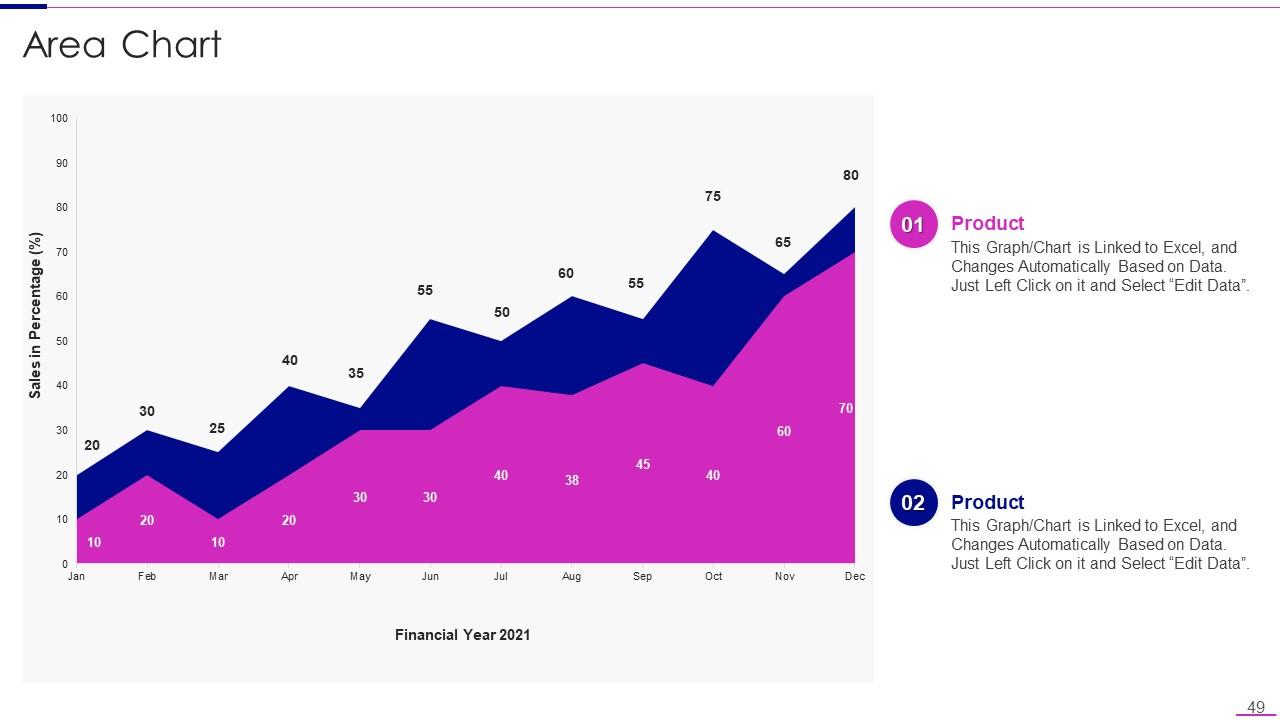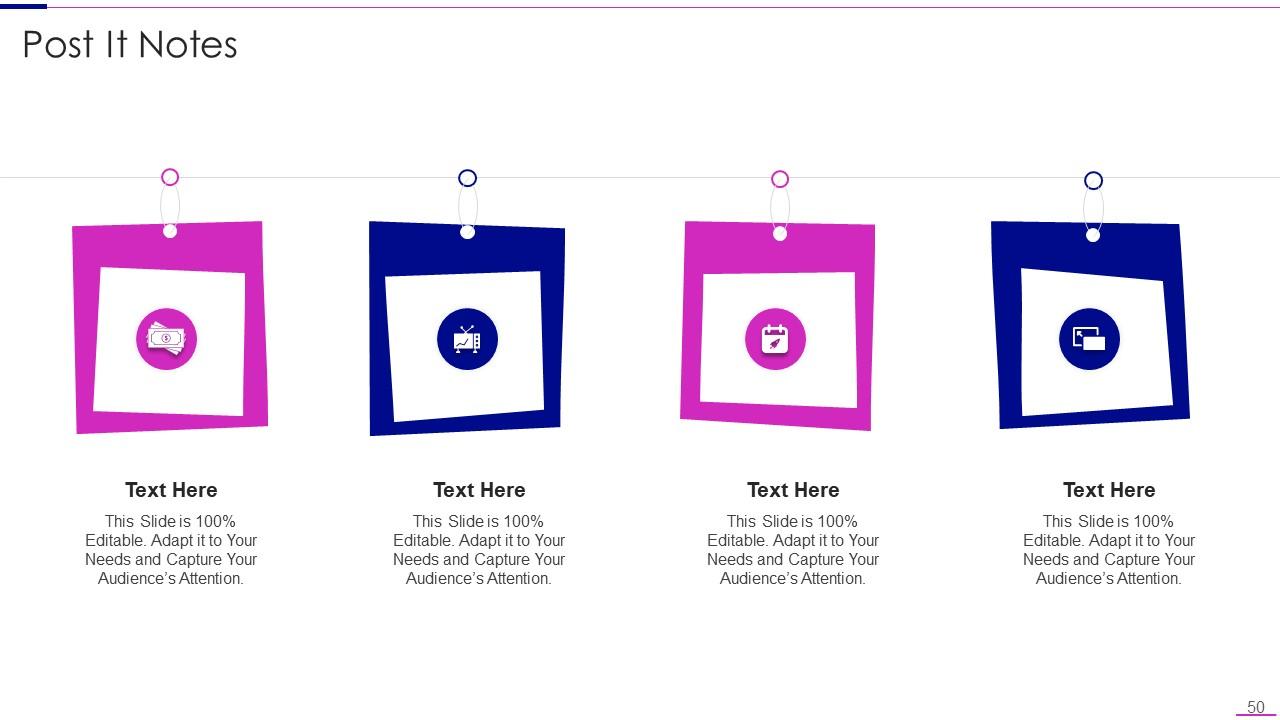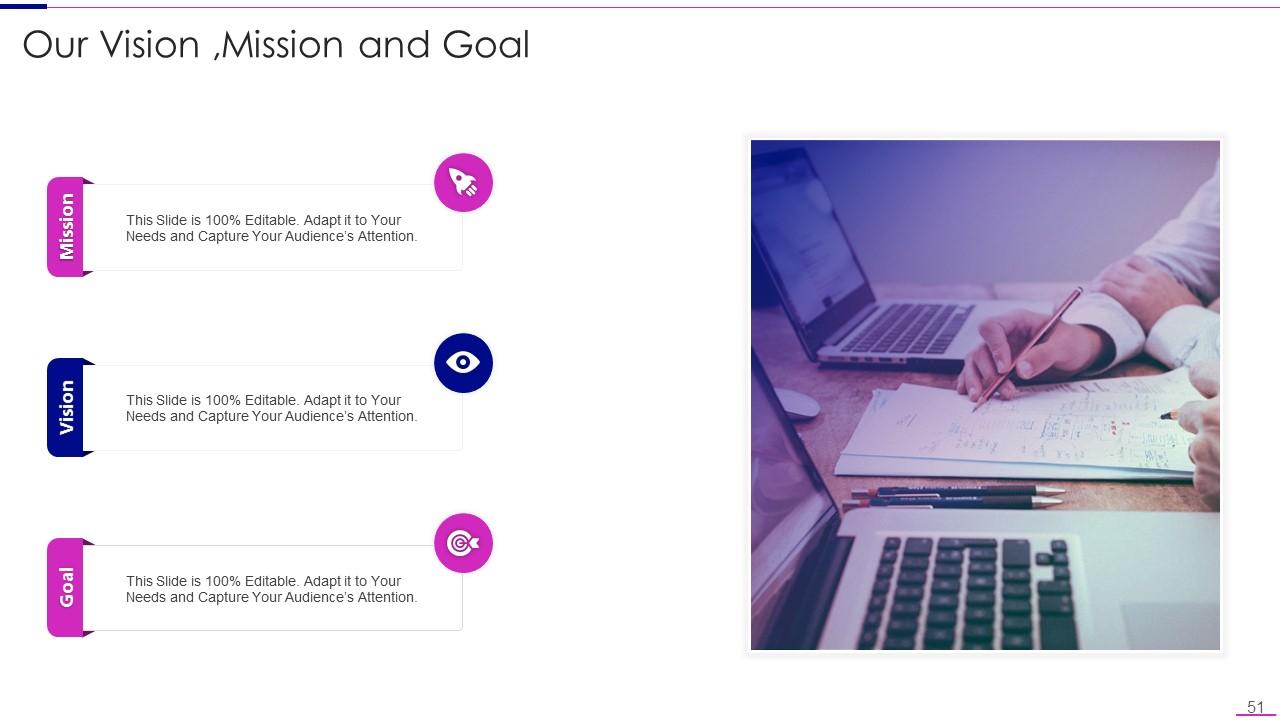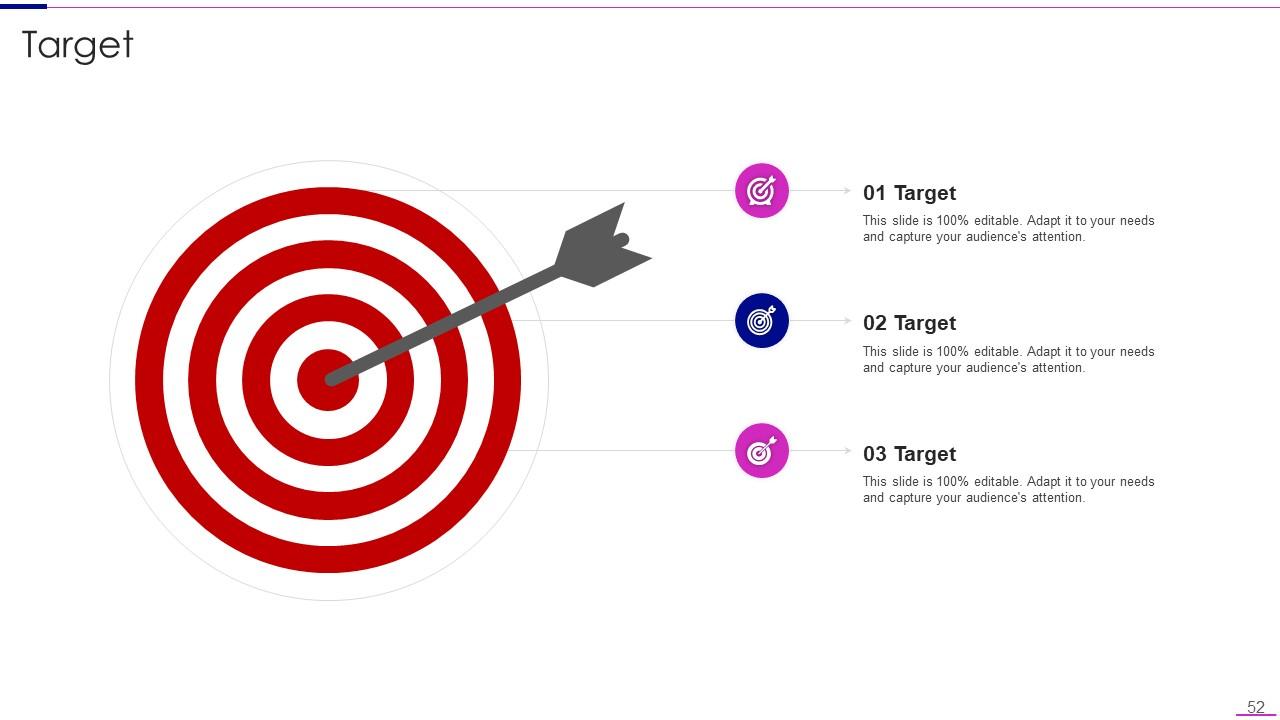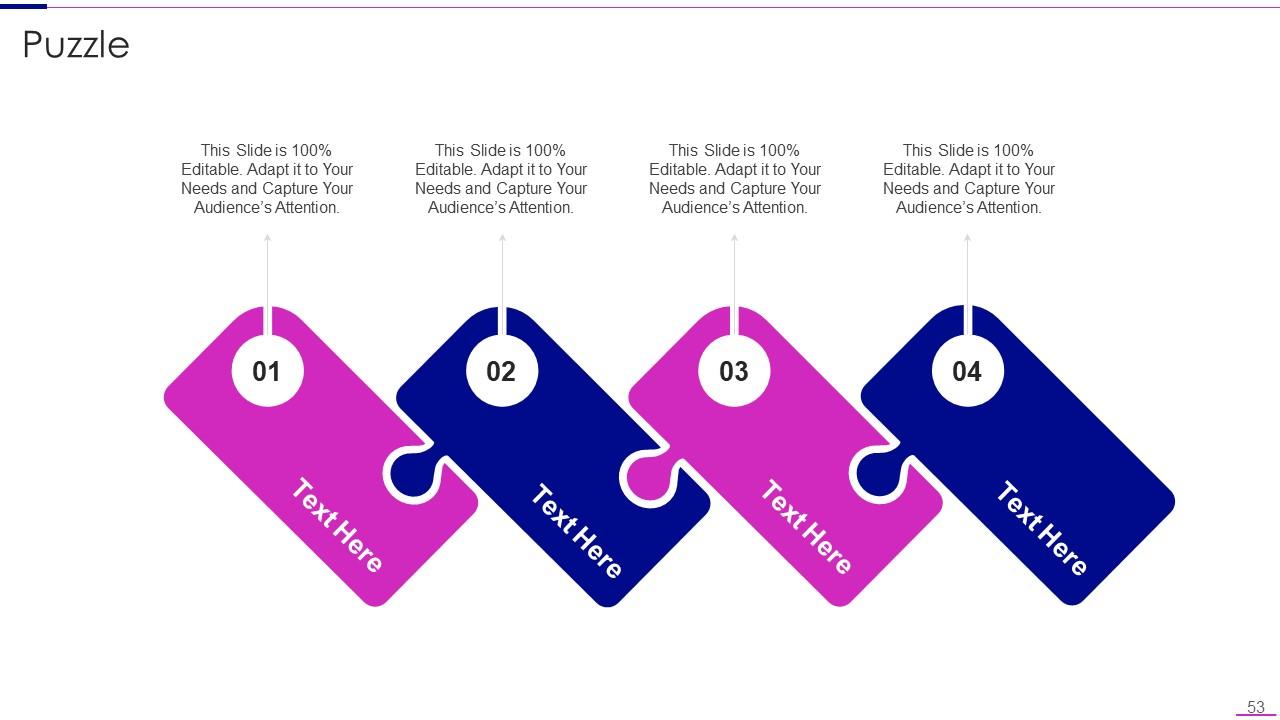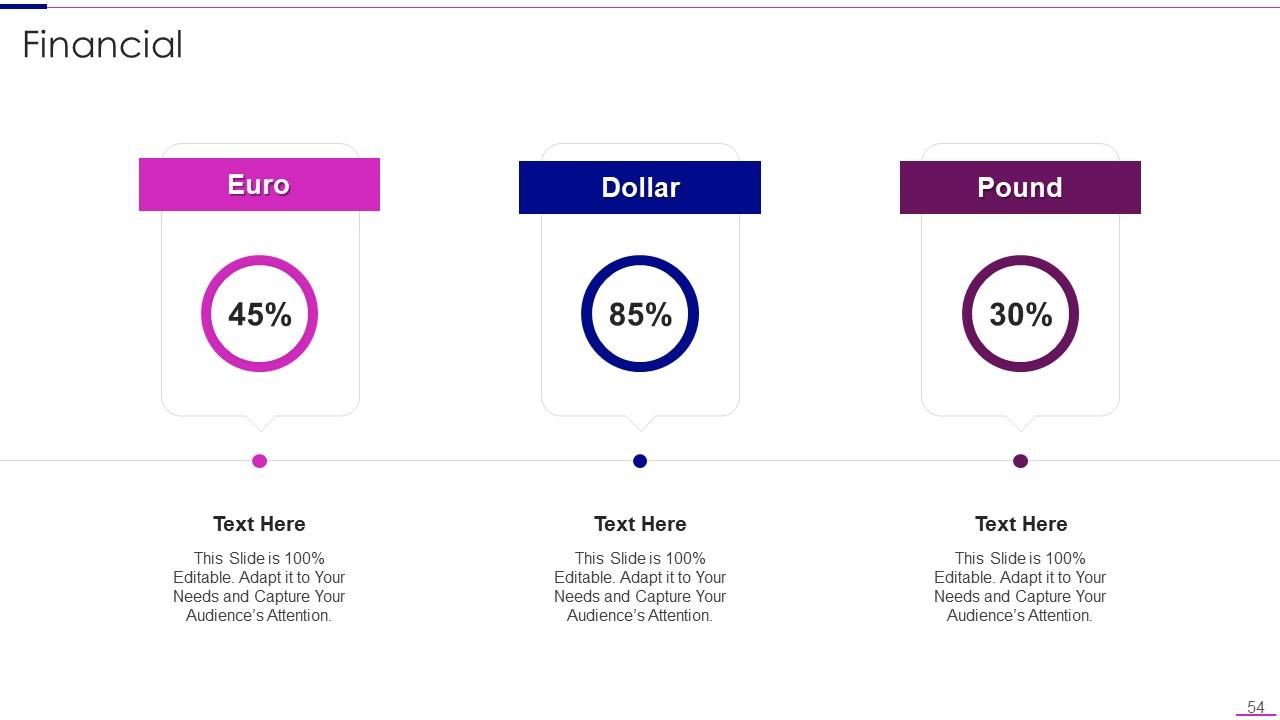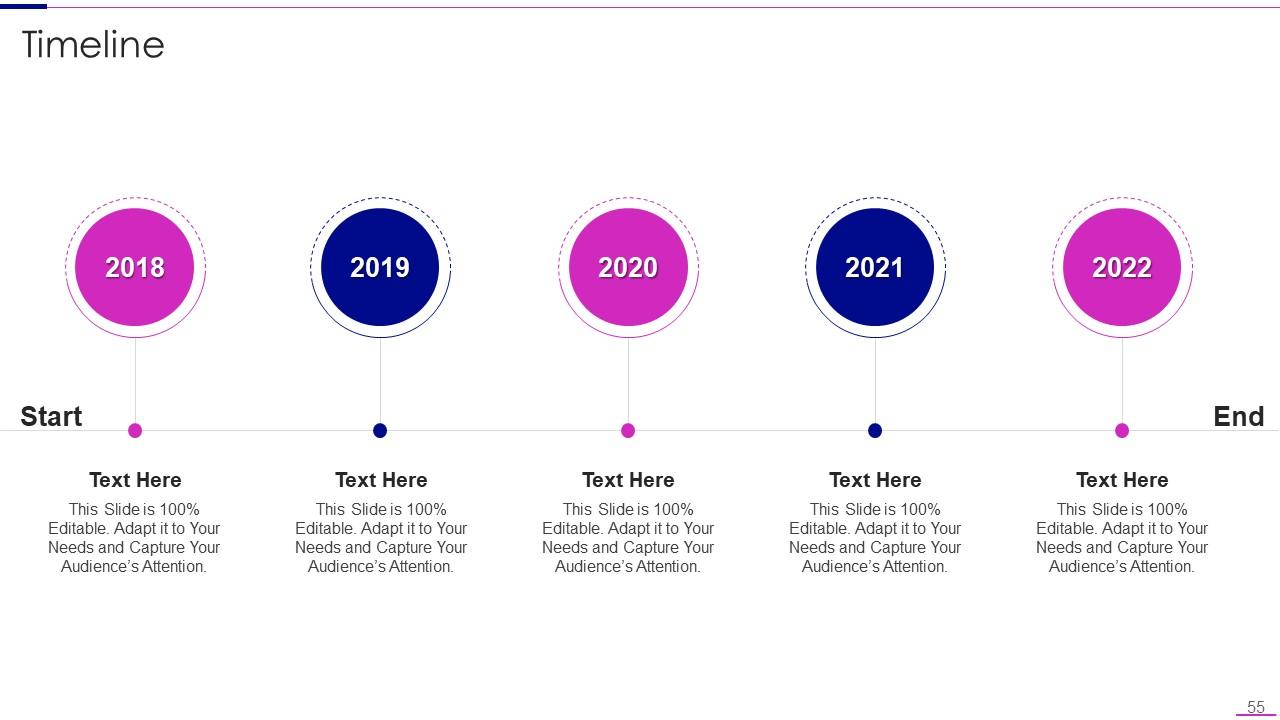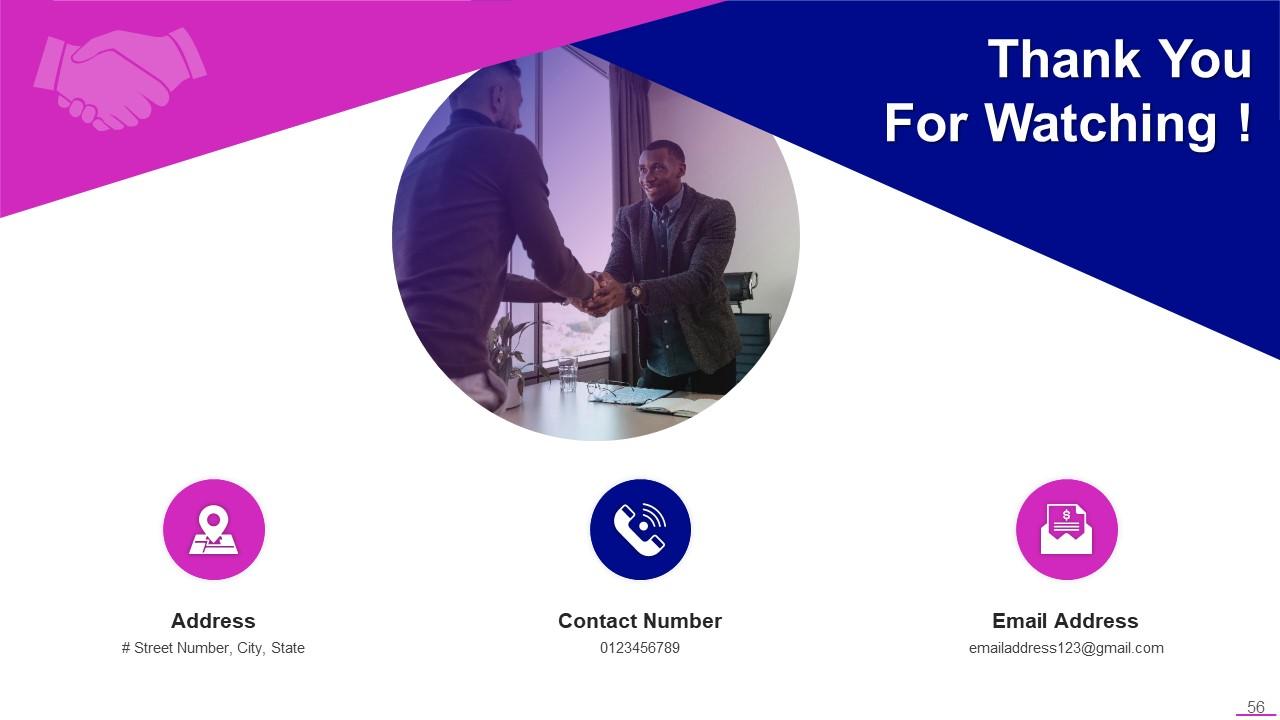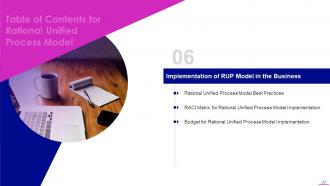Rational Unified Process Model Powerpoint Presentation Slides
The Rational Unified Process RUP is an agile software development technique that divides a projects life cycle, or software development, into four phases. To successfully implement the agile methodology, it becomes crucial for you to have a step-by-step guide in place, which is where this module exists. It talks about various stages, including Modeling, analysis, design, implementation, testing, and application. The template addresses the problems faced by software development companies by presenting the statistics in a bar graph. Also, it talks about using the RUP methodology to overcome the issues. This proposal covers the need for RUP implementation in the business, an overview of RUP, its various phases, and its benefits and disadvantages. In addition, this template contains working of RUP, a checklist to implement RUP in the company, best practices, a RACI matrix, and a budget for the implementation. Moreover, it caters to the impacts of RUP implementation on business and software development. Lastly, this RUP Methodology deck comprises a 30-60-90 days plan to implement RUP in the company and a roadmap. Download our 100 percent editable and customizable template.
The Rational Unified Process RUP is an agile software development technique that divides a projects life cycle, or software..
- Google Slides is a new FREE Presentation software from Google.
- All our content is 100% compatible with Google Slides.
- Just download our designs, and upload them to Google Slides and they will work automatically.
- Amaze your audience with SlideTeam and Google Slides.
-
Want Changes to This PPT Slide? Check out our Presentation Design Services
- WideScreen Aspect ratio is becoming a very popular format. When you download this product, the downloaded ZIP will contain this product in both standard and widescreen format.
-

- Some older products that we have may only be in standard format, but they can easily be converted to widescreen.
- To do this, please open the SlideTeam product in Powerpoint, and go to
- Design ( On the top bar) -> Page Setup -> and select "On-screen Show (16:9)” in the drop down for "Slides Sized for".
- The slide or theme will change to widescreen, and all graphics will adjust automatically. You can similarly convert our content to any other desired screen aspect ratio.
Compatible With Google Slides

Get This In WideScreen
You must be logged in to download this presentation.
PowerPoint presentation slides
Deliver this complete deck to your team members and other collaborators. Encompassed with stylized slides presenting various concepts, this Rational Unified Process Model Powerpoint Presentation Slides is the best tool you can utilize. Personalize its content and graphics to make it unique and thought provoking. All the fifty six slides are editable and modifiable, so feel free to adjust them to your business setting. The font, color, and other components also come in an editable format making this PPT design the best choice for your next presentation. So, download now.
People who downloaded this PowerPoint presentation also viewed the following :
Content of this Powerpoint Presentation
Slide 1: This slide introduces Rational Unified Process Model. State Your Company Name and begin.
Slide 2: This is an Agenda slide. State your agendas here.
Slide 3: This slide presents Table of Content for the presentation.
Slide 4: This is another slide continuing Table of Content for the presentation.
Slide 5: This slide shows title for 'Current situation of the company'.
Slide 6: This slide depicts the software development problems experienced by the company.
Slide 7: This slide represents the cost of rectifying and fix software problems after deployment.
Slide 8: This slide highlights title for 'Need for RUP Implementation'.
Slide 9: This slide depicts the industries that use rational unified process methodology.
Slide 10: This slide represents the companies who deployed rational unified process model by company size.
Slide 11: This slide represents the benefits of the rational unified process.
Slide 12: This slide displays title for 'Overview of RUP'.
Slide 13: This slide represents a rational unified process and how it helps prevent resource waste and unexpected development expenses.
Slide 14: This slide depicts the rational unified process building blocks.
Slide 15: This slide represents the various phases of the rational unified process.
Slide 16: This slide depicts the detailed phases of the rational unified process.
Slide 17: This slide presents title for 'RUP Working'.
Slide 18: This slide depicts the working of the rational unified process.
Slide 19: This slide represents continued content.
Slide 20: This slide describes the main and supportive workflows of rational unified process.
Slide 21: This slide exhibits title for 'Checklist to implement RUP in business'.
Slide 22: This slide represents the requirements management guidelines for the rational unified process model.
Slide 23: This slide depicts the use of a component-based architecture with the rational unified process.
Slide 24: This slide illustrates the use of visual software models in the RUP model.
Slide 25: This slide depicts the software quality check guidelines in the rational unified process.
Slide 26: This slide represents how management and control change software is easy in the rational unified process.
Slide 27: This slide shows title for 'Implementation of RUP in business'.
Slide 28: This slide depicts the best practices for the rational unified process.
Slide 29: This slide depicts the RACI matrix for rational unified process implementation.
Slide 30: This slide depicts the budget for rational unified process implementation by resources.
Slide 31: This slide highlights title for 'RUP Disciplines'.
Slide 32: This slide depicts the disciplines of the rational unified process methodology.
Slide 33: This slide represents the rational unified process discipline implementation process and its outcomes.
Slide 34: This slide describes the rational unified process disciplinary testing goals.
Slide 35: This slide displays title for 'RUP & other methodologies'.
Slide 36: This slide depicts a comparison of the rational unified process model and waterfall model.
Slide 37: This slide depicts the rational unified process and scrum methodology.
Slide 38: This slide presents title for 'RUP Impacts'.
Slide 39: This slide depicts the impacts of the rational unified process model on business.
Slide 40: This slide describes the impacts of rational unified process methodology on software development.
Slide 41: This slide exhibits title for '30-60-90 days plan for implementation'.
Slide 42: This slide describes the 30-60-90 days plan to implement the rational unified process in the company.
Slide 43: This slide shows title for 'Roadmap for implementation'.
Slide 44: This slide depicts the roadmap to implement the rational unified process in the organization.
Slide 45: This slide displays Icons for Rational Unified Process Model.
Slide 46: This slide is titled as Additional Slides for moving forward.
Slide 47: This slide shows Disadvantages of Rational Unified Process Model.
Slide 48: This slide describes Line chart with two products comparison.
Slide 49: This slide depicts Area chart with two products comparison.
Slide 50: This slide shows Post It Notes. Post your important notes here.
Slide 51: This is Our Mission slide with related imagery and text.
Slide 52: This is Our Target slide. State your targets here.
Slide 53: This slide contains Puzzle with related icons and text.
Slide 54: This is a Financial slide. Show your finance related stuff here.
Slide 55: This is a Timeline slide. Show data related to time intervals here.
Slide 56: This is a Thank You slide with address, contact numbers and email address.
Rational Unified Process Model Powerpoint Presentation Slides with all 61 slides:
Use our Rational Unified Process Model Powerpoint Presentation Slides to effectively help you save your valuable time. They are readymade to fit into any presentation structure.
FAQs
RUP(Rational Unified Process ) is a software development process framework that provides a structured approach for designing, developing, and deploying software applications.
Some benefits of implementing RUP (Rational Unified Process) include increased efficiency and productivity, reduced development costs, improved software quality, and better project management and control.
The RUP (Rational Unified Process ) model consists of four phases: inception, elaboration, construction, and transition. Each phase represents a distinct stage of the software development process.
RUP (Rational Unified Process ) is often compared to traditional waterfall models and agile methodologies like Scrum. While RUP shares similarities with both, it places a greater emphasis on iterative development and risk management.
To implement RUP (Rational Unified Process ) in a business, it is important to have a clear understanding of the company's software development goals, available resources, and team capabilities. It is also essential to establish a solid RUP implementation plan and ensure proper training and support for the development team.
-
Great product with effective design. Helped a lot in our corporate presentations. Easy to edit and stunning visuals.
-
Attractive design and informative presentation.


